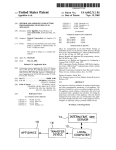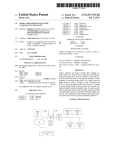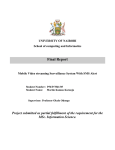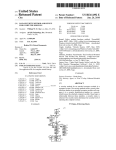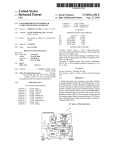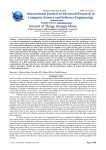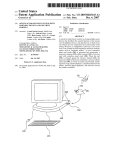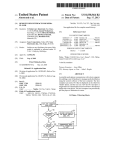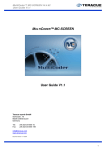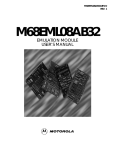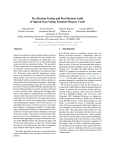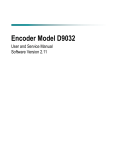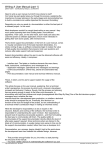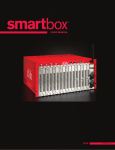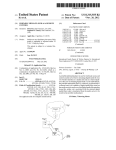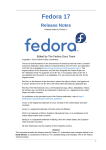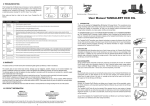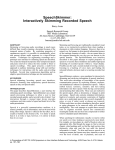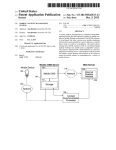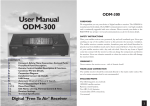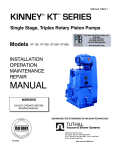Download Personal media broadcasting system
Transcript
US007877776B2 (12) Ulllted States Patent (10) Patent N0.: Krikorian et al. US 7,877,776 B2 (45) Date of Patent: Jan. 25, 2011 (54) PERSONAL MEDIA BROADCASTING SYSTEM 5,602,589 A 5,610,653 A 5,661,516 A 2/1997 Vishwanath et a1. 3/1997 Abecassis 8/1997 Carles (75) Inventors: Jason Krikorian, San Mateo, CA (US); 5,666,426 A 9/1997 Helms Blake Krikorian, San Mateo, CA (US) (73) Assignee: Sling Media, Inc., Foster City, CA (U S) (*) Notice: (Continued) Subject to any disclaimer, the term of this patent is extended or adjusted under 35 U.S.C. 154(b) by 1424 days. FOREIGN PATENT DOCUMENTS CN 1464685 12/2003 (21) App1.No.: 11/147,664 (22) Filed: Jun. 7, 2005 (65) (Continued) Pl‘lOl‘ Publication Data Us 2006/0095471 A1 OTHER PUBLICATIONS May 4’ 2006 ReplayTV 5000 User’s Guide, 2002, entire document.* Related US. Application Data (60) Prov1s1onal appl1cat1on No. 60/577,833, ?led on Jun. Primar ExamineriHumer B‘ Lonsbe 7 2004 ’ (51) (Continued) y ' “y 74 Allorn 6)’, A genl, 0r Firmilng rassia Fisher & Lorenz, RC. Int. Cl. H04N 7/18 H04N 7/173 (2006.01) (2006.01) (57) (52) US. Cl. ......................... .. 725/95; 725/80; 725/133; (58) _ _ _ Field of Classi?cation Search ..... ......... .. 725/80, S 1, _ ?l f 1 725 141’ 93*97 725/ 141 ee app lcanon e or Comp ete Seam References Cited (56) ABSTRACT . . . . . A personal med1a broadcastmg system enables v1deo d1str1 bution Overa computernetwork and allows auserto View and control media sources over a computer network from a lstory' remote location. A personal broadcaster receives an input from one or more types of media sources, digitiZes and com presses the content, and streams the compressed media over a computer netWork to a media player running on any of a Wide U.S. PATENT DOCUMENTS 3,416,043 A 12/1968 Jorgensen range of client devices for viewing the media. The“ system _ 4 254 303 A 3/l98l Takizawa may alloW the user to 1ssue control commands (e.g., channel 5,161,021 A 11/1992 Tsai up”) from the media player to the broadcaster, causing the 5,237,648 A 8/l993 Mills et 31 source device to execute the commands. The broadcaster and 5,386,493 A 5’434’590 A M1995 D eg en et Al 7/l995 Dinwiddie Jr et a1 the media player may employ several techniques for buffer ing, transmitting, and vieWing the content to improve the 5,434,678 A 7/1995 Abecassis user 5 expenence 5,438,423 A 8/1995 Lynch et a1. 5,493,638 A 2/1996 Hooper et a1. 52 Claims, 2 Drawing Sheets Central Server m A/V Source Devices Q Home Internet C ‘ Jig , Personal Broadcaster OmNetwork m Storage Device 1_3_0 Local Clients Remote Clients E E1 US 7,877,776 B2 Page 2 US. PATENT DOCUMENTS 5,682,195 5,684,918 5,696,869 5,706,290 5,708,961 5,710,605 5,722,041 5,757,416 5,774,170 5,778,077 5,794,116 5,822,537 5,831,664 5,850,482 5,852,437 5,880,721 5,892,536 5,898,679 5,909,518 5,911,582 5,922,072 5,936,968 5,953,485 5,968,132 5,987,501 6,002,450 6,008,777 6,014,694 6,020,880 6,031,940 6,036,601 6,040,829 6,043,837 6,049,671 6,075,906 6,088,455 6,088,777 6,091,886 6,097,441 6,104,334 6,108,041 6,115,420 6,117,126 6,141,059 6,141,447 6,151,444 6,160,544 6,201,536 6,208,805 6,212,282 6,222,885 6,223,211 6,240,459 6,240,531 6,243,596 6,256,019 6,263,503 6,279,029 6,282,714 6,286,142 6,340,994 6,353,885 6,356,945 6,357,021 6,370,688 6,389,467 6,408,128 6,434,113 6,442,067 6,456,340 6,466,623 10/1997 11/1997 12/1997 1/1998 1/1998 1/1998 2/1998 5/1998 6/1998 7/1998 8/1998 10/1998 11/1998 12/1998 12/1998 3/1999 4/1999 4/1999 6/1999 6/1999 7/1999 8/1999 9/1999 10/1999 11/1999 12/1999 12/1999 1/2000 2/2000 2/2000 3/2000 3/2000 3/2000 4/2000 6/2000 7/2000 7/2000 7/2000 8/2000 8/2000 8/2000 9/2000 9/2000 10/2000 10/2000 11/2000 12/2000 3/2001 3/2001 4/2001 4/2001 4/2001 5/2001 5/2001 6/2001 7/2001 7/2001 8/2001 8/2001 9/2001 1/2002 3/2002 3/2002 3/2002 4/2002 5/2002 6/2002 8/2002 8/2002 9/2002 10/2002 Hendricks et al. Abecassis Abecassis Shaw et al. Hylton et al. Nelson Freadman Birch et al. Hite et al. Davidson Matsuda et al. Katseff et al. Wharton et al. Meany et al. Wugofski et al. Yen Logan et al. Brederveld et al. Chui Redford et al. Hutchinson et al. Lyons Abecassis Tokunaga Hamilton et al. Darbee et al. Yiu Aharoni et al. Naimpally Chui et al. Heckel Croy et al. Driscoll, Jr. et al. Slivka et al. FenWick et al. Logan et al. Sorber Abecassis Allport Allport Faroudja et al. Wang Appelbaum et al. Boyce et al. LinZer et al. Abecassis Hayashi et al. Hendricks et al. Abecassis Mershon Chaddha et al. Hamilton et al. Roberts et al. Spilo et al. Kikinis Allport Margulis Sampat et al. Ghori et al. Ehreth Margulis et al. HerZi et al. Shaw et al. Kitagawa et al. Hejna, Jr. Eyal Abecassis Gubbi Chawla et al. Margulis Youn et al. 6,470,378 6,476,826 6,487,319 6,493,874 6,496,122 6,505,169 6,510,177 6,529,506 6,553,147 6,553,178 6,557,031 6,564,004 6,567,984 6,584,201 6,584,559 6,597,375 6,598,159 6,600,838 6,609,253 6,611,530 6,628,716 6,642,939 6,647,015 6,658,019 6,665,751 6,665,813 6,697,356 6,701,380 6,704,678 6,704,847 6,708,231 6,718,551 6,754,266 6,754,439 6,757,851 6,757,906 6,766,376 6,768,775 6,771,828 6,774,912 6,781,601 6,785,700 6,795,638 6,798,838 6,806,909 6,807,308 6,816,194 6,816,858 6,826,242 6,834,123 6,839,079 6,847,468 6,850,571 6,850,649 6,868,083 6,889,385 6,892,359 6,898,583 6,907,602 6,927,685 6,930,661 6,931,451 6,941,575 6,944,880 6,952,595 6,981,050 7,016,337 7,020,892 7,032,000 7,047,305 7,055,166 7,058,376 7,110,558 10/2002 11/2002 11/2002 12/2002 12/2002 1/2003 1/2003 3/2003 4/2003 4/2003 4/2003 5/2003 5/2003 6/2003 6/2003 7/2003 7/2003 7/2003 8/2003 8/2003 9/2003 11/2003 11/2003 12/2003 12/2003 12/2003 2/2004 3/2004 3/2004 3/2004 3/2004 4/2004 6/2004 6/2004 6/2004 6/2004 7/2004 7/2004 8/2004 8/2004 8/2004 8/2004 9/2004 9/2004 10/2004 10/2004 11/2004 11/2004 11/2004 12/2004 1/2005 1/2005 2/2005 2/2005 3/2005 5/2005 5/2005 5/2005 6/2005 8/2005 8/2005 8/2005 9/2005 9/2005 10/2005 12/2005 3/2006 3/2006 4/2006 5/2006 5/2006 6/2006 9/2006 Tracton et al. Plotkin et al. Chai Humpleman Sampsell Bhagavath et al. De Bonet et al. Yamamoto et al. Chai et al. Abecassis Mimura et al. Kadono Allport Konstantinou et al. Huh et al. YaWitZ McAlister et al. Chui SWiX et al. Apostolopoulos Tan et al. Vallone et al. Malkemes et al. Chen et al. Chen et al. Forsman et al. Kretschmer et al. Schneider et al. Minke et al. Six et al. Kitagawa SWiX et al. Bahl et al. Hensley et al. Park et al. Look et al. Price Wen et al. Malvar Ahmed et al. Cheung Masud et al. Skelley, Jr. Ngo Radha et al. Chui et al. Zhang et al. Coden et al. Ojard et al. Acharya et al. Barlow et al. Ferriere Tardif Malvar Apostolopoulos et al. Rakib et al. Nason et al. Rising, III Tsai et al. Wathen Uchida et al. Logan et al. Allen Allen Ikedo et al. Tobias et al. Wu et al. Levesque et al. Tripp Brooks et al. Logan et al. Logan et al. Elliott US 7,877,776 B2 Page3 7,124,366 7,151,575 7,155,734 7,155,735 7,184,433 7,224,323 7,239,800 7,344,084 7,430,360 7,430,686 7,464,396 7,502,733 7,505,480 7,565,681 7,661,121 2001/0021998 2002/0004839 2002/0010925 2002/0012530 2002/0031333 2002/0046404 2002/0053053 2002/0080753 2002/0090029 2002/0105529 B2 B1 B1 B1 B1 B2 B2 B2 B2 B1 B2 B2 B1 B2 B2 A1 A1 A1 A1 A1 A1 A1 A1 A1 A1 10/2006 12/2006 12/2006 12/2006 2/2007 5/2007 7/2007 3/2008 9/2008 9/2008 12/2008 3/2009 3/2009 7/2009 2/2010 9/2001 1/2002 1/2002 1/2002 3/2002 4/2002 5/2002 6/2002 7/2002 8/2002 Foreman eta1. Landryet a1. ShiInOmura eta1. Ngo eta1. oz Uchida eta1. Bilbrey DaCosta Abecassis Wang eta1. Hejna, Jr. Andrsen eta1. Zhang eta1. Ngo eta1. Smith eta1. Margulis Wine eta1. Kikinis Bruls Mano eta1. Mizutani Nagai et a1. Lee Kim Bowser eta1. 2005/0055595 2005/0060759 2005/0097542 2005/0114852 2005/0132351 2005/0138560 2005/0198584 2005/0204046 2005/0216851 2005/0227621 2005/0229118 2005/0246369 2005/0251833 2005/0262539 2005/0283791 2005/0288999 2006/0011371 2006/0015925 2006/0031381 2006/0050970 2006/0051055 2006/0095401 2006/0095472 2006/0095942 2006/0095943 A1 A1 A1 A1 A1 A1 A1 A1 A1 A1 A1 A1 A1 A1 A1 A1 A1 A1 A1 A1 A1 A1 A1 A1 A1 3/2005 3/2005 5/2005 5/2005 6/2005 6/2005 9/2005 9/2005 9/2005 10/2005 10/2005 11/2005 11/2005 11/2005 12/2005 12/2005 1/2006 1/2006 2/2006 3/2006 3/2006 5/2006 5/2006 5/2006 5/2006 Frazer eta1. Rowe eta1. Lee Chen eta1. Randa11eta1. Lee eta1. Matthews et a1. watanabe Hull eta1. Katoh Chiu eta1. Oreizy eta1. Schedivy Barton eta1. Mocarthyetal. Lerner et a1. Fahey Logan van Luijt et a1. Gunatilake Ohkawa Krikorian eta1. Krikorian eta1. van Beek Demircin eta1. 2002/0112247 A1 8/2002 Horner et a1. 2006/0107226 A1 2002/0120925 2002/0122137 2002/0131497 2002/0138843 A1 A1 A1 A1 8/2002 9/2002 9/2002 9/2002 Logan Chen eta1. Jang Samaan eta1. 2006/0117371 2006/0146174 2006/0280157 2006/0280437 A1 A1 A1 A1 6/2006 7/2006 12/2006 12/2006 5/2006 Matthews et a1. Margulis Hagino Karaoguz eta1. Logan eta1. 2002/0143973 2002/0147634 2002/0147687 2002/0167458 2002/0188818 2002/0191575 2003/0001880 2003/0028873 2003/0065915 2003/0093260 2003/0093790 2003/0095791 2003/0115167 2003/0159143 2003/0187657 2003/0192054 2003/0208612 2003/0231621 2004/0003406 2004/0052216 2004/0068334 2004/0083301 2004/0100486 2004/0103340 A1 A1 A1 A1 A1 A1 A1 A1 A1 A1 A1 A1 A1 A1 A1 A1 A1 A1 A1 A1 A1 A1 A1 A1 10/2002 10/2002 10/2002 11/2002 12/2002 12/2002 1/2003 2/2003 4/2003 5/2003 5/2003 5/2003 6/2003 8/2003 10/2003 10/2003 11/2003 12/2003 1/2004 3/2004 4/2004 4/2004 5/2004 5/2004 Price Jacoby eta1. Breiter et a1. Baudisch eta1. Nimura eta1. Kalavade eta1. Holtz eta1. Lemmons Yu eta1. Dagtas et a1. Logan eta1. Barton eta1. shanfet a1. chan Erhart eta1. Birks et a1. Harris et a1. Gubbi et a1. Billmaier Roh Tsai et a1. Murase eta1. Flannni et a1. Sundareson eta1. 2007/0003224 2007/0005783 2007/0022328 2007/0074115 2007/0076604 2007/0113250 2007/0168543 2007/0180485 2007/0198532 2007/0234213 2007/0286596 2007/0300258 2008/0019276 2008/0036917 2008/0037573 2008/0059533 2008/0134267 2008/0195744 2008/0199150 2008/0294759 2008/0307456 2008/0307462 2008/0307463 2009/0074380 A1 A1 A1 A1 A1 A1 A1 A1 A1 A1 A1 A1 A1 A1 A1 A1 A1 A1 A1 A1 A1 A1 A1 A1 1/2007 1/2007 1/2007 3/2007 4/2007 5/2007 7/2007 8/2007 8/2007 10/2007 12/2007 12/2007 1/2008 2/2008 2/2008 3/2008 6/2008 8/2008 8/2008 11/2008 12/2008 12/2008 12/2008 3/2009 Krikorian eta1. Saint-Hillaire eta1. Tarra eta1. Patten eta1. Litwack Logan eta1. Krikorian eta1. Dna Krikorian eta1. Krikorian eta1. Lonn O’Connoretal. Takatsuji eta1. Pascarella eta1. Cohen Krikorian Moghe eta1. Bowraetal. Candelore Biswas et a1. Beetcher et a1. Beetcher et a1. Beetcher et a1. Boston eta1. 2004/0139047 A1 7/2004 Rechsteiner et a1. 2009/0199248 Al* 8/2009 Ngo eta1. ................... .. 725/90 2004/0162845 A1 2004/0162903 A1 8/2004 Kim eta1. 8/2004 Oh 2010/0100915 A1 4/2010 Krikorian eta1. 2004/0172410 A1 2004/0205830 2004/0212640 2004/0216173 2004/0236844 2004/0255249 2004/0255330 2004/0255334 2004/0255336 2005/0005308 2005/0021398 2005/0027821 2005/0038981 2005/0044058 2005/0050462 2005/0053356 A1 A1 A1 A1 A1 A1 A1 A1 A1 A1 A1 A1 A1 A1 A1 9/2004 Shimojima et a1. 10/2004 10/2004 10/2004 11/2004 12/2004 12/2004 12/2004 12/2004 1/2005 1/2005 2/2005 2/2005 2/2005 3/2005 3/2005 Kaneko Mann eta1. Horoszowski et a1. Kocherlakota chang eta1. Logan Logan Logan eta1. Logan eta1. McCleskey eta1. Alexander et a1. Connor etal. Matthews et a1. Whittle eta1. Mate et a1. FOREIGN PATENT DOCUMENTS DE EP EP EP EP EP GB JP JP JP KR KR WO W0 4407319 0838945 1077407 1443766 1691550 1830558 2307151 2003046582 2003114845 2004015111 19990082855 20010211410 0133839 WO 01/33839 A1 A A1 A2 A A1 A A A A A A A1 9/1994 4/1998 2/2001 8/2004 8/2006 9/2007 5/1997 2/2003 4/2003 V2004 ll/l999 8/2001 5/2001 5/2001 US 7,877,776 B2 Page 4 WO WO WO WO W0 WO WO WO WO WO WO WO WO WO WO 0147248 0193161 03026232 03052552 W0 03/052552 03098897 2004032511 2005050898 2006064454 2006074110 2007027891 2007051156 2007141555 2007149466 2008024723 A2 A1 A1 A2 A A1 A2 A1 A A2 A2 A2 A2 A 6/2001 12/2001 3/2003 6/2003 6/2003 11/2003 4/2004 6/2005 6/2006 7/2006 3/2007 5/2007 12/2007 12/2007 2/2008 OTHER PUBLICATIONS International Search Report for International Application No. PCT/ US2007/076337 mailed Oct. 20. 2008. Rao, PadmanabhaR.,U.S.Appl.No. 12/347,465, ?led Dec. 31, 2008. European Patent Of?ce, European Search Report for European Application No. EP 08 16 7880, mailed Mar. 4, 2009. MythTV Wiki, “MythTV User Manual” [Online], Aug. 27, 2007, XP002515046; retrieved from the Internet: <URL: http://www. mythtv.org/wiki?title:UseriManual:Introduction&oldid:25549>. International Searching Authority, Written Opinion and International Search Report for International Application No. PCT/US2008/ 077733, mailed Mar. 18, 2009. International Searching Authority, Written Opinion and International Search Report for International Application No. PCT/US2008/ 087005, mailed Mar. 20, 2009. Watanabe Y. et al., “Multimedia Database System for TV Newscasts and Newspapers”; Lecture Notes in Computer Science, Springer Verlag, Berlin, Germany; vol. 1554, Nov. 1, 1998, pp. 208-220, myreplaytv.com/ Aug. 15, 2000, entire document.* XP002402824, ISSN: 0302-9743. Yasuhiko Watanabe et al., “Aligning Articles in TV Newscasts and Newspapers”; Proceedings of the International Conference on Faucon, B., “TV ‘Brick’ Opens up Copyright Can of Worms,” Finan cial Review, Jul. 1, 2003, [online] [Retrieved on Apr. 12, 2006] XP002402825. http://web.archive.org/web/20000815052751/http://www. Retrieved from the Internet <URL:http://afr.com/cgi-bin/ newteXtversions.pl?storyid:1056825330084&date:2003/07/01& pagetype:printer§ion:1053 801318705&path:/aIticles/2003/ 06/30/1056825330084.html >. Computationallinguistics, XX, XX, Jan. 1, 1998, pp. 1381-1387, Sodergard C. et al., “Integrated Multimedia Publishing: Combining TV and Newspaper Content on Personal Channels”; Computer Net works, Elsevier Science Publishers B.V., Amsterdam, Netherlands; vol. 31, No. 11-16, May 17, 1999, pp. 1111-1128, XP004304543, ISSN: 1389-1286. Ariki Y. et al., “Automatic Classi?cation of TV News Articles Based Archive of “TV Brick Home Server,” www.tvbrick.com, [online] [Archived by http://archive.org on Jun. 3, 2004; Retrieved on Apr. 12, 2006] Retrieved from the Internet <URL:http://web.archive.org/ on Telop Character Recognition”; Multimedia Computing and Sys web/20041 10711 1024/www.tvbrick.com/en/af?liate/tvbs/tvbrick/ tems, 1999; IEEE International Conference on Florence, Italy, Jun. tvbrick/document18iprint >. PCT International Search Report and Written Opinion, PCT/US05/ 20105, Feb. 15, 2007, 6 pages. 7-11, 1999, Los Alamitos, CA, USA, IEEE Comput. Soc. US; vol. 2, Jun. 7, 1999, pp. 148-152, XP010519373, ISBN: 978-0-7695-0253 Krikorian, Jason, U.S. Appl. No. 11/734,277, ?led Apr. 12, 2007. Tarra, Raghuveer et al., U.S. Appl. No. 60/975,239, ?led Sep. 26, 2007. Rao, Padmanabha R., U.S. Appl. No. 12/166,039, ?led Jul. 1,2008. Williams, George Edward, U.S. Appl. No. 12/167,041, ?led Jul. 2, 2008. Faucon, B. “TV ‘Brick’ Opens up Copyright Can of Worms, ”Finan cial Review, Jul. 1, 2003, [online [Retrieved on Apr. 12, 2006] Retrieved from the Internet, URL:http://afr.com/c gi-bin/newtextver sions.pl?storyid+1056825330084&3ate+2003/07/01& pagetype+printer§ion+1053 801318705&path+articles/2003/ 06/30/0156825330084.html.]. Archive of “TV Brick Home Server,” www.tvbrick.com, [online] [Archived by http://archive.org on Jun. 3, 2004; Retrieved on Apr. 12, 2006] retrieved from the Internet <URL:http://web.archive.org/web/ 200411071 11024/www.tvbrick.com/en/af?liate/tvbs/tvbriclddocu ment18/print>. PCT International Search Report and Written Opinion, PCT/ US2005/020105, Feb. 15, 2007, 6 pages. Roe, Kevin, “Third-Party Observation Under EPC Article 115 On The Patentability Of An Invention,” Dec. 21, 2007. Roe, Kevin, Third-Party Submission For Published Application Under CFR §1.99, Mar. 26, 2008. Skodras et al., “JPEG2000: The Upcoming Still Image Compression Standard,” May 11, 2000, 14 pages. Kessler, Gary C., An Overview of TCP/IP Protocols and the Internet; Jan. 16, 2007, retrieved from the Internet on Jun. 12, 2008 at http:// 3; abstract, paragraph [03.1], paragraph [05.2], ?gures 1,2. USPTO, Non-Final Of?ce Action mailed Dec. 17, 2004; U.S. Appl. No. 09/809,868, ?led Mar. 15, 2001. USPTO, Final Of?ce Action mailed Jul. 28, 2005; U.S. Appl. No. 09/809,868, ?led Mar. 15, 2001. USPTO, Non-Final Of?ce Action mailed Jan. 30, 2006; U.S. Appl. No. 09/809,868, ?led Mar. 15, 2001. USPTO, Final Of?ce Action mailed Aug. 10, 2006; U.S. Appl. No. 09/809,868, ?led Mar. 15, 2001. USPTO, Non-Final Of?ce Action mailed Jun. 19, 2007; U.S. Appl. No. 09/809,868, ?led Mar. 15, 2001. USPTO, Non-Final Of?ce Action mailed Apr. 16, 2008; U.S. Appl. No. 09/809,868, ?led Mar. 15, 2001. USPTO, Final Of?ce Action mailed Sep. 18, 2008; U.S. Appl. No. 09/809,868, ?led Mar. 15, 2001. USPTO, Non-Final Of?ce Action mailed Mar. 31, 2009; U.S. Appl. No. 09/809,868, ?led Mar. 15, 2001. USPTO, Non-Final Of?ce Action mailed May 1, 2008; U.S. Appl. No. 11/111,265, ?led April 21, 2005. USPTO, Final Of?ce Action mailed Dec. 29, 2008; U.S. Appl. No. 11/111,265, ?led Apr. 21, 2005. USPTO, Non-Final Of?ceAction mailed Jun. 8, 2009; U.S.Appl. No. 11/111,265, ?led Apr. 21, 2005. USPTO, Non-Final Of?ce Action mailed Jun. 26, 2008; U.S. Appl. No. 11/620,707, ?led Jan. 7, 2007. USPTO, Final Of?ce Action mailed Oct. 21, 2008; U.S. Appl. No. 11/620,707, ?led Jan. 7, 2007. USPTO, Non-Final Of?ce Action mailed Mar. 25, 2009; U.S. Appl. No. 11/620,707, ?led Jan. 7, 2007. www.garykesslernet/library/tcpip.htrnl; originally submitted to the USPTO, Non-Final Of?ce Action mailed Aug. 7, 2008; U.S. Appl. InterNIC and posted on their Gopher site on Aug. 5, 1994. Taubman et al., “Embedded Block Coding In JPEG2000,” Feb. 23, 2001, pp. 1-8 of36. Balster, Eric J ., “Video Compression and Rate Control Methods Based on the Wavelet Transform,” The Ohio State University 2004, No. 11/620,711, ?led Jan. 7, 2007. USPTO, Final Of?ce Action mailed Feb. 9, 2009; U.S. Appl. No. 11/620,711, ?led Jan. 7, 2007. USPTO, Non-Final Of?ce Action mailed Feb. 25, 2009; U.S. Appl. No. 11/683,862, ?led Mar. 8,2007. USPTO, Non-Final Of?ce Action mailed Dec. 24, 2008; U.S. Appl. No. 11/147,985, ?led Jun. 7, 2005. USPTO, Non-Final Of?ce Action mailed Jun. 25, 2008; U.S. Appl. No. 11/428,254, ?led Jun. 30, 2006. USPTO, Final Of?ce Action mailed Feb. 6, 2009; U.S. Appl. No. 11/428,254, ?led Jun. 30, 2006. pp. 1-24. Kulapala et al., “Comparison of Traf?c and Quality Characteristics of Rate-Controlled Wavelet and DCT Video,” AriZona State University, Oct. 11, 2004. International Search Report and Written Opinion for PCT/US2006/ 04382, mailed Apr. 27, 2007. US 7,877,776 B2 Page 5 Veri?cation & Quali?cation: Bluetooth Technical Background, Apr. 21, 1999; pp. 1 of7 and 2 of 7; http://www.bluetooth.com/v2/news/ show.asp 1-2. International Search Report for PCT/US2008/069914 mailed Dec. 19, 2008. PCT Partial International Search, PCT/U S2009/ 054893, mailed Dec. 23, 2009. Microsoft Corporation; Harman/Kardon “Master Your Universe” European Patent Of?ce, European Search Report, mailed Sep. 28, 1999. Matsushita Electric Corporation of America MicroCast : Wireless PC 2009 for European Application No. EP 06 78 6175. DitZe M. et all “Resource Adaptation for Audio -Visual Devices in the Multimedia Transceiver System, Nov. 1998. “Wireless Local Area Networks: Issues in Technology and Stan dards” Jan. 6, 1999. USPTO, Final Of?ce Action mailed Jun. 25, 2009; U.S. Appl. No. 11/147,985, ?led Jun. 7, 2005. China State Intellectual Property Of?ce “First Of?ce Action,” issued UPnP QoS Architecture,” Advanced Networking and Applications, Jul. 31, 2009, for Application No. 200580026825.X. USPTO, Non-Final Of?ce Action, mailed Aug. 4, 2009; U.S. Appl. No. 11/734,277, ?led Apr. 12, 2007. USPTO, Final Of?ce Action, mailed Jul. 31, 2009; U.S. Appl. No. 11/683,862, ?led Mar. 8, 2007. USPTO, Non-Final Of?ce Action, mailed Aug. 5, 2009; U.S. Appl. No. 11/147,663, ?led Jun. 7, 2005. USPTO, Non-Final Of?ce Action, mailed Sep. 3, 2009; U.S. Appl. No. 11/620,711, ?led Jan. 7,2007. Einaudi, Andrew E. et al. “Systems and Methods for Selecting Media Content Obtained from Multiple Sources,” U.S. Appl. No. 12/543,278, ?led Aug. 18, 2009. Malode, Deepak Ravi “Remote Control and Method for Automati cally Adjusting the Volume Output of an Audio Device,” U.S. Appl. No. 12/550,145, ?led Aug. 28, 2009. Akella, Aparna Sarma “Systems and Methods for Event Program ming Via a Remote Media Player,” U.S. Appl. No. 12/537,057, ?led Aug. 6, 2009. Shah, Bhupendra Natwerlan et al. “Systems and Methods for Transcoding and Place Shifting Media Content,” U.S. Appl. No. USA, Jan. 23-27, 2006. Lowekamp, B. et al. “A Hierarchy of Network Performance Charac teristics for Grid Applications and Services,” GGF Network Mea 12/548,130, ?led Aug. 26, 2009. 16, 2009. Rao, Padmanabha R. et al. “Methods and Apparatus for Establishing Network Connections Using an Inter-Mediating Device,” U.S. Appl. No. 12/642,368, ?led Dec. 18, 2009. Dham, Vikram et al. “Systems and Methods for Establishing Network Connections Using Local Mediation Services,” U.S. Appl. No. 12/644,918, ?led Dec. 22, 2009. Paul, John et al. “Systems and Methods for Remotely Controlling Media Server Via a Network,” U.S. Appl. No. 12/645,870, ?led Dec. 23, 2009. Bajpal, Parimal et al. “Method and Node for Transmitting Data Over a Communication Network using Negative Ackhowledgement,” U.S. Appl. No. 12/404,920, ?led Mar. 16, 2009. Bajpal, Parimal et al. “Method and Note for Employing Network connections Over a Connectinoless Transport Layer Protocol,” U.S. Appl. No. 12/405,062, ?led Mar. 16, 2009. Asnis, Ilya et al. “Mediated Network address Translation Traversal” U.S. Appl. No. 12/405,039, ?led Mar. 16,2009. Australian Government “Of?ce Action,” Australian Patent Applica tion No. 2006240518, mailed Nov. 12, 2009. Jain, Vikal Kumar “Systems and Methods for Coordinating Data Communication Between Two Device,” U.S. Appl. No. 12/ 699,280, ?led Feb. 3, 2010. Gangotri, Arun L. et al. “Systems and Methods and Program Appli Bluetooth-News; Main Future User Models Document Banger, Shashidhar et al. “Systems and Methods for Automatically Controlling the Resolution of Streaming Video Content,” U.S. Appl. No. 12/537,785, ?led Aug. 7, 2009. Panigrahi, Biswaranjan “Home Media Aggregator System and Method,” U.S. Appl. No. 12/538,681, ?led Aug. 10,2009. Nandury, Venkata Ki shore “Adaptive Gain Control for Digital Audio Samples in a Media Stream,” U.S. Appl. No. 12/507,97 1, ?led Jul. 23, 2009. Shirali, Amey “Systems and Methods for Providing Programming Content,” U.S. Appl. No. 12/538,676, ?led Aug. 10,2009. Thiyagaraj an, Venkatesan “Systems and Methods for Virtual Remote Control of Streamed Media,” U.S. Appl. No. 12/538,664, ?led Aug. 10, 2009. Thiyagarajan, Venkatesan et al. “Localization Systems and Method,” U.S. Appl. No. 12/538,783, ?led Aug. 10, 2009. Shirali, Amey et al. “Methods and Apparatus for Seeking Within a Media Stream Using Scene Detection,” U.S. Appl. No. 12/ 538,784, ?led Aug. 10, 2009. Thiyagarajan, Venkatesan “Systems and Methods for Updating Firmware Over a Network,” U.S. Appl. No. 12/538,661, ?led Aug. 10, 2009. Iyer, Sati sh “Methods and Apparatus for Fast Seeking Within a Media Stream Buffer,” U.S. Appl. No. 12/538,659, ?led Aug. 10,2009. European Patent Of?ce, International Searching Authority, “Interna tional Search Report,” for International Application No. PCT/ US2009/049006, mailed Sep. 11, 2009. China State Intellectual Property Of?ce “First Of?ce Action,” issued Jan. 8, 2010, for Application No. 200810126554.0. USPTO, Final Of?ce Action mailed Nov. 6, 2009; U.S. Appl. No. 09/809,868, ?led Mar. 15, 2001. USPTO, Final Of?ce Action mailed Nov. 12, 2009; U.S. Appl. No. 11/620,707, ?led Jan. 7, 2007. USPTO, Non-Final Of?ce Action mailed Oct. 1, 2009; U.S. Appl. No. 11/778,287, ?led Jul. 16,2007. USPTO, Non-Final Of?ce Action mailed Nov. 23, 2009, U.S. Appl. No. 11/683,862, ?led Mar. 8, 2007. USPTO Final Of?ce action mailed Jan. 25, 2010; U.S. Appl. No. 11/734,277, ?led Apr. 12,2007. 2006; AINA, 2006; 20% H International conference on Vienna, Aus tria Apr. 18-20, 2006. Joonbok, Lee et al. “Compressed High De?nition Television (HDTV) Over IPv6,” Applications and the Internet Workshops, 2006; Saint Workshops, 2006; International Symposium, Phoenix, AZ, surements Working Group, pp. 1-29, May 24, 2004. Newton’s Telcom Dictionary, 21st ed., Mar. 2005. Sling Media “Sling Media Unveils Top-of-Line SlingboX PRO-HD” [online], Jan. 4, 2008, XP002560049; retrieved from the Internet: URL:www.slingmedia.com/get/pr-slingboX-pro-hd.html; retrieved on Oct. 12, 2009. Srisuresh, P. et al. “Traditional IP Network Address Translator (Tra ditional NAT),” Network Working Group, The Internet Society, Jan. 2001. Lucas, Brian et al. “Systems and Methods for Establishing Connec tions Between Devices Communicating Over aNetwork,” U.S. Appl. No. 12/426,103, ?led Apr. 17,2009. Thiyagaraj an, Venkatesan et al. “Always-On-Top Media Player Launched From a Web Browser,” U.S. Appl. No. 12/617,271, ?led Nov. 12, 2009. Paul, John Michael et al. “Systems and Methods for Delivering Messages Over a Network,” U.S. Appl. No. 12/619,192, ?led Nov. cations for Selectively Restructuring the Placeshiftnig of Copy Pro tected Digital Media Content,” U.S. Appl. No. 12/ 623,955, ?led Nov. 23, 2009. Paul, John et al. “Systems and Methods for Searching Media Con tent,” U.S. Appl. No. 12/648,024, ?led Dec. 28, 2009. Carlson, T. “Mule 2.x Getting Started Guide,” Apr. 15, 2008, 134 pages. Curtis, Sean “Systems and Methods for Formatting Media Content for Distribution,” U.S. Appl. No. 12/635,138, ?led Dec. 10, 2009. Newton’s Telcom Dictionary, 20th ed., Mar. 2004. “The Authoritative Dictionary of IEEE Standard Terms,” 7th ed. 2000. GurZhi, Alexander et al. “Systems and Methods for Emulating Net work-Enabled Media Components,” U.S . Appl. No. 12/711,830, ?led Feb. 24, 2010. US 7,877,776 B2 Page 6 Bajpai, Parimal et al. “Systems and Methods of Controlling the Encoding ofa Media Stream,” U.S. Appl. No. 12/339,878, ?led Dec. 19, 2008. Malone, Edward D. et al. “Systems and Methods for Controlling Media Devices,” U.S. Appl. No. 12/256,344, ?led Oct. 22, 2008. Banger, Shashidhar et al. “Systems and Methods for Determining Attributes of Media Items Accessed Via a Personal Media Broad caster,” U.S. Appl. No. 12/334,959, ?led Dec. 15,2008. Kulkarni, Anant Madhava “Systems and Methods for Creating Logi cal Media Streams for Media Storage and Playback,” U.S. Appl. No. 12/323,907, ?led Nov. 26, 2008. Rao, Padmanabha R. “Systems and Methods for Linking Media Content,” US. Appl. No. 12/359,784, ?led Jan. 26, 2009. Krikorian, Blake Gary et al. “Systems and Methods for Presenting Media Content Obtained From Multiple Sources,” US. Appl. No. 12/408,456, ?led Mar. 20, 2009. Krikorian, Blake Gary et al. “Systems and Methods for Projecting Images From a Computer System,” US. Appl. No. 12/408,460, ?led Mar. 20, 2009. International Search Report and Written Opinion for International Application No. PCT/US2006/025911, mailed Jan. 3, 2007. International Search Report for International Application No. PCT/ US2007/063599, mailed Dec. 12, 2007. International Search Report and Written Opinion for International Application No. PCT/US2008/080910, mailed Feb. 16, 2009. International Search Report and Written Opinion for International Application No. PCT/US2006/025912, mailed Jul. 17, 2008. International Search Report for International Application No. PCT/ US2008/059613, mailed Jul. 21, 2008. Wikipedia “LocationFree Player” [Online], Sep. 22, 2007, XP002512400; retrieved from the Internet: <URL: http://en. wikipedia.org/w/index.php?title:LocationFreeiPlayer& USPTO Final Of?ce Action mailed Mar. 12, 2010; US. Appl. No. 11/620,711, ?led Jan. 7, 2007. USPTO Final Of?ce Action mailed Mar. 3, 2010; US. Appl. No. 11/111,265, ?led Apr. 21, 2005. USPTO Non-Final Of?ce Action mailed Mar. 31, 2010; US. Appl. No. 11/620,707, ?led Jan. 7, 2007. USPTO Non-Final Of?ce Action mailed Apr. 1, 2010; US. Appl. No. 12/237,103, ?led Sep. 24, 2008. Qiong, Liu et al. “Digital Rights Management for Content Distribu tion,” Proceedings of the Australasian Information Security Work shop Conference on ACSW Frontiers 2003, vol. 21, 2003, XP002571073, Adelaide, Australia, ISSN: 1445-1336, ISBN: 1-920682-00-7, sections 2 and 2.1.1. China State Intellectual Property Of?ce “Of?ce Action” issued Mar. 18, 2010 for Application No. 2006800225206. Canadian Intellectual Property Of?ce “Of?ce Action” mailed Feb. 18, 2010 for Application No. 2569610. European Patent Of?ce “European Search Report,” mailed May 7, 2010 for Application No. 067861740. China State Intellectual Property Of?ce “Of?ce Action” issued Apr. 13, 2010 for Application No. 200580026825.X. Margulis, Neal “Apparatus and Method for Effectively Implementing aWireless Television System,” US. Appl. No. 12/758,193, ?led Apr. 12, 2010. Margulis, Neal “Apparatus and Method for Effectively Implementing aWireless Television System,” US. Appl. No. 12/758,194, ?led Apr. 12, 2010. Margulis, Neal “Apparatus and Method for Effectively Implementing aWireless Television System,” US. Appl. No. 12/758,196, ?led Apr. 12, 2010. Kirkorian, Jason Gary et al. “Personal Media Broadcasting System with Output Buffer,” U.S. Appl. No. 12/757,697, ?led Apr. 9, 2010. Tarra, Raghuveer et al. “Firmware Update for Consumer Electronic oldid:159683564>; retrieved on Jan. 28, 2009. Device,” U.S. Appl. No. 12/757,714, ?led Apr. 9, 2010. Wikipedia “Slingbox” [Online], Oct. 21, 2007, XP002512399; Lee, M. et al. “Video Frame Rate Control for Non-Guaranteed Net retrieved from the Internet: <URL:http://en.wikipedia.org/w/index. php?title:Slingbox&oldid:166080570>; retrieved on Jan. 28, 2009. Capable Networks LLC “Keyspan Remote Control4Controlling work Services with Explicit Rate Feedback,” Globecom’00, 2000 IEEE Global Telecommunications conference, San Francisco, CA, Nov. 27-Dec. 1, 2000; [IEEE Global Telecommunications Confer Your Computer With a Remote” [Online], Feb. 21, 2006, XP002512495; retrieved from the Internet: <URL:http://www. XP001195580; ISBN: 978-0-7803-6452-3, lines 15-20 of sec. II on slingcommunity.com/article/1 1791/Keyspan-Remote-Control-Controlling-Your-Computer-With-a-Remote/? highlight:remote+control>; retrieved on Jan. 28, 2009. Sony Corporation “LocationFree Player PakiLocationFree Base StationiLocationFree Player” [Online] 2005, XP002512401; retrieved from the Internet: <URL:http://www.docs.sony.com/re lease/LFPK1.pdf>; retrieved on Jan. 28, 2009. Sling Media Inc. “Slingbox User Guide” [Online] 2006, XP002512553; retrieved from the Internet: <URL:http://www. ence], NewYork, NY; IEEE, US, vol. 1,Nov. 27, 2000, pp. 293-297, p. 293, ?g. 1. European Patent Of?ce, International Searching Authority, “Interna tional Search Report and Written Opinion,” mailed Jun. 4, 2010 for International Application No. PCT/IN2009/000728, ?led Dec. 18, 2009. USPTO Non-Final Of?ce Action mailed Jun. 23, 2010; US. Appl. No. 11/933,969, ?led Nov. 1,2007. Korean Intellectual Property Of?ce “Of?cial Notice of Preliminary Rejection,” issued Jun. 18, 2010; Korean Patent Application No. slingmediahIdattach/en-USiSlingboxiUseriGuideiv1 .2 .pdf>; 10-2008-7021254. retrieved on Jan. 29, 2009. Japan Patent Of?ce “Notice of Grounds for Rejection (Of?ce Action),” mailed May 25, 2010; Patent Application No. 2007 Sony Corporation “LocationFree TV” [Online], 2004, SP002512410; retrieved from the Internet: <URL:http://www.docs. sony.com/releaselLFX1iX5revision.pdf>; retrieved on Jan. 28, 2009 [noteidocument uploaded in two parts as ?le exceeds the 25MB siZe limit]. European Patent Of?ce, International Searching Authority, “Interna tional Search Report,” mailed Mar. 30, 2010; International Applica tion PCT/US2009/068468 ?led Dec. 27, 2009. 0268269. Japan Patent Of?ce “Notice of Grounds for Rejection (Of?ce Action),” mailed May 25, 2010; Patent Application No. 2007 527683. USPTO Non-Final Of?ce Action mailed Aug. 11, 2010; US. Appl. No. 11/111,265 ?led Apr. 21, 2005. * cited by examiner US. Patent Jan. 25, 2011 Sheet 1 012 US 7,877,776 B2 Central Server 180 H e‘m1mwm1acmy m 06 6 t. B Pm68rdnl0&0 mm n sO s r MDm5 we as 0 SNb6%1Wer2vwM3 bo er Local Clients 150 Remote Clients 170 FIG. 1 Home Internet Gateway 1_1Q E Q: IR Emitter E FIG. 2 US. Patent Jan. 25, 2011 US 7,877,776 B2 Sheet 2 0f 2 6:250 motE I26xmo83tV06Bi2E %a .OEm .82>aqwlmmIE aB29E:;2m“El?m|o motuE 5o9wAnl_:>.w mmm 8m Al 25%: 2 % US 7,877,776 B2 1 2 PERSONAL MEDIA BROADCASTING SYSTEM users to access their A/V content from any of a variety of remote locations inside or outside the home, as such content is currently available only from locations in the home that traditionally receive and play it (e.g., a television set). CROSS REFERENCE TO RELATED APPLICATIONS SUMMARY OF THE INVENTION This application claims the bene?t of US. Provisional A personal media broadcasting system enables video trans Application No. 60/577,833, ?led Jun. 7, 2004, Which is incorporated by reference in its entirety. This application is also related to co-pending US. Application entitled, “Fast Start Streaming and Buffering of Streaming Content for Per sonal Media Player,” to Krikorian et al., ?led Jun. 7, 2005, and co-pending US. Application entitled, “Personal Media Broadcasting System With Output Buffer,” to Krikorian et al., ?led Jun. 7, 2005, each of Which is incorporated by reference in its entirety. mission over a computer netWork, alloWing a user to vieW and control media sources over a computer netWork from a remote location. In one embodiment, the personal media broadcasting system includes a personal media broadcaster and a media player. The personal media broadcaster may be con?gured to receive as an input virtually any media source. The broadcaster digitiZes and compresses the received media content (if necessary) and streams the media over a computer netWork to the media player. The media player may reside on any of a Wide range of client devices for vieWing the media. A BACKGROUND 1. Field of the Invention 20 This invention relates generally to personal streaming media broadcasters, and in particular to streaming media by the media player. In one embodiment, a personal media broadcasting system includes a personal media broadcaster and media player cli from a media source input to a client device over a network. 2. Background of the Invention While people spend a great deal of time Watching televi sion programming and other forms of audio-visual (A/V) content, they are also spending an increasing amount of time interfacing With computing devices such as personal comput 25 ent, Which communicate With each other over a netWork. The personal media broadcaster can accept an A/V signal from one or more A/V source devices. From this A/V signal, the ers, personal digital assistants, mobile phones, dedicated multimedia devices, and other devices that, like the tradi tional television, include a display. These types of computing user may send control commands (e.g., “channel up”) using the media player back over the netWork to be executed by the media source device, thus affecting the media stream received 30 personal media broadcaster constructs a media stream that is suitable for transmission over a netWork to the media player client. The personal media broadcaster includes a netWork interface for transmitting the media stream to the media devices alloW people to be increasingly mobile, but this mobility reduces the time people spend at home in front of player client. As the media stream is received at the client, it their televisions. It Would therefore be bene?cial to enable of A/V content they noW receive at home on these computing embodiment, the personal media broadcaster is a dedicated appliance, not a general purpose computer. In this Way, a general purpose computer need not be poWered on and con devices as Well, regardless of location and Without depen nected to theA/V source devices for the user to receive media dence on physical connections. content remotely. In another embodiment, the media player people to enjoy their television programming and other forms can be vieWed by a user using the media player client. In one 35 This ability Would enable several desirable applications. For example, a user might Want to access and control televi sion and other regularly consumed A/V content from a per sonal computer (desktop as Well as notebook computers) or other computing devices around the home via the user’ s local netWork in the home. Since cable, satellite, and other sources of television content typically enter the house at a feW discrete client can run on any general or multi-purpose device (such as 40 a personal computer or cellular phone), bene?cially avoiding the need for the user to carry special equipment to use the 45 locations, alloWing access to the content over a home netWork gives the user more freedom to enjoy the content throughout the home. Another possible application Would be to enable a broadcasting system. The computer netWork over Which the broadcaster and media player client communicate may com prise a Wide area netWork, such as the Internet, alloWing the user to receive media content from the home to anyWhere in the World Where a connection to the netWork is available. To improve the user’ s experience, the person media broad casting system may employ any of a number of techniques for user to access and control television and other A/V content buffering, transmitting, and vieWing the content. In one from any number of remote netWorks Where a broadband 50 embodiment, for example, the media stream is constructed by connection is available to the user (e.g., at an airport, at Work, at school, in a hotel, in a cafe, at an acquaintance’s house).Yet encoding the audio/visual signal using a bit rate selected at another application Would be to enable a user to access and intermediate output buffer used to temporarily store the media stream before it is transmitted to the media player least in part based on an amount of free space remaining in an control television and otherA/V content from a mobile phone or other computing devices that can be connected to a Wide 55 area netWork (e.g., GPRS, W-CDMA, CDMA-2000, lXRTT, lXEVDO, and the like). In various applications, users are likely to Want to access their media content stored on devices, such as personal computers and other devices having storage, from remote netWorks. Nevertheless, netWork bandWidth and other limitations have made it dif?cult to provide an effective and enjoyable remote media experience for the user. But traditional streaming media solutions do not enable these applications in any effective Way; moreover, they suffer from technical limitations that Would prevent their use in personal media broadcasting applications like those described above. Accordingly, it Would be desirable to enable 60 client. While various measures of occupancy of the interme diate output buffer can be used, one involves the use of mul tiple Watermarks to measure the free space available in the buffer. The encoding bit rate can be decreased each time the free space dips beloW a Watermark, While it can be increased When the free space rises above a Watermark or if the free space never drops beloW the Watermark in the ?rst place. In this Way, the encoding bit rate can be dynamically adjusted based on current performance of the system, and this dynamic 65 adjustment can occur at the broadcaster Without requiring feedback from the client. In another embodiment, the media player client imple ments a fast-start mechanism by Which the media player US 7,877,776 B2 4 3 The system described herein may be applied in a number of receives a media stream in real time from the personal media broadcaster and stores the media stream in a buffer. The applications or usage scenarios. For example, there are a variety of uses in the home over a Wired or Wireless home media player client plays the received media stream from the buffer at a decreased playback speed Without Waiting for the buffer to ?ll to a predetermined threshold. While the playback speed is kept at a sloWer rate than the streaming media content netWork for the system. In the home, users can vieW and control their A/V source components, such as a personal video recorder (PVR) or a cable set-top box, from any desktop PC, notebook PC, PDA, or other netWork devices. For is received, the buffer ?lls (albeit at a rate sloWer than the media stream is received). This alloWs the media player client to play a received media stream Without Waiting for its buffer example, this application alloWs a user to convert a Wireless notebook PC situated in the kitchen into a Wireless LCD TV. As another example of in-home use, young parents can pair a to ?lls, Which improves the user’s experience dramatically in personal broadcaster With a simple analog camera and place situations such as Where the user is changing channels or operating a menu on the remote A/V source device. In addi them in the baby’ s room to provide a real time video and audio stream of their child displayed on a device in another location in the home. Another usage scenario category relates to users Who are aWay from home but have access to a broadband connection. This access can be in a variety of locations, such as at Work, at school, at a friend’s house, in a cafe, at the airport or in a tion, the media player client may further enhance this expe rience by sWitching into a control mode When the client receives a user command to control content in the media stream. When the client enters the control mode, the buffer is ?ushed and the received media stream is played. In this Way, the content in the buffer need not be displayed on the client device, and the user can then almost immediately receive visual feedback con?rming the user’s command to control plane, or in a hotel. From these locations, users can connect to 20 content in the media stream. their personal broadcaster over the public Internet and enjoy the same live television experience that they have at home. The present invention alloWs users that are aWay from home to access the full breadth of programming they are accus BRIEF DESCRIPTION OF THE DRAWINGS tomed to, and even vieW content that they previously captured FIG. 1 is a block diagram of a media broadcasting system, in accordance With an embodiment of the invention. FIG. 2 is a block diagram of a set of input and output connections for a personal media broadcaster, in accordance 25 With an embodiment of the invention. FIG. 3 is a block diagram of a personal media broadcaster, in accordance With an embodiment of the invention. 30 DETAILED DESCRIPTION OF THE PREFERRED EMBODIMENTS 35 OvervieW Embodiments of the invention alloW for distribution ofA/V RTSP, RTP, RSVP, and the like. Because embodiments of the invention can accept, digitiZe, encode, and stream any analog content from a variety of A/V source devices over a computer netWork to a client device. As used herein, A/V content may on their personal video recorder. Yet another usage scenario category relates to individuals With mobile phones, communicators, or other Wide area net Work devices. On emerging netWorks, the bit rate is noW high enough for users to enjoy streaming video on their devices. This opens up neW possibilities for the personal broadcaster to deliver a Wealth of programming to the mobile user, all of Which originates from the user’s oWn home. The media stream transmitted from the personal media broadcaster to the media player client netWorks can take advantage of a combination of any number of netWorking protocols, including HTTP over TCP/IP, as Well as UDP, 40 A/V source, there are a vast number of uses for the personal broadcasterifrom a security camera system to a method for include any type of media content, including audio or video extending a user’s satellite radio to the user’s cell phone. content, or both. In one embodiment, a personal media broad caster takes as an input an audio or video signal, digitiZes and System Architecture FIG. 1 is a block diagram of the media broadcasting system compresses the content (e.g., in WindoWs Media Video, MPEG-4, or H.264), and streams the content over an IP 45 in accordance With one embodiment of the invention. As netWork (such as IP4 or IP6) to a client device for vieWing and/ or listening to the content. The personal broadcaster, Which may be implemented as an embedded solution, may alloW the user to issue control commands, such as “channel up” via an IR or serial command, back over the netWork to be illustrated, a personal media broadcaster 100 is con?gured to receive an input video signal from a Wide variety of A/V source devices 120. For example, any component or device 50 from a connectedA/V source device 120, the personal broad caster digitiZes, encodes, and streams the digitally com executed by the original source device. Using various embodiments of the present invention, a user can connect to the personal broadcaster a cable or satellite set-top box, a personal video recorder, a DVD player, a DVD jukebox, a music server, a satellite radio receiver, a camcorder, a digital video recorder (DVR) or any other A/V source component. pressed media to the home Internet gateWay 11 0. The gateWay 55 a single device that encompasses one or more of these func 60 media player may be a softWare application that runs on a client device, Which is con?gured to receive the media stream created by the personal broadcaster. Different client softWare applications can exist for different classes of client devices, such as personal computers and cell phones. The client may be able to connect to the personal broadcaster through a Web broWser interface. 110 may comprise one or more separate devices, including a router, a sWitch or hub, and/or an analog, DSL, cable or other type of broadband modem, or the gateWay 110 may comprise This Way, the user can vieW and control the live output of these sources from any netWorked device. Various embodi ments of the present invention may include different compo nents, including a personal broadcaster and media player. The having analog A/V outputs can be connected to the personal broadcaster 100. Upon receiving the video and/ or audio feed 65 tions. The gateWay 110 may be coupled to a local area netWork (LAN) 140 that couples several computing devices in a user’ s home. According to knoWn techniques, any number of local clients 150 may be able to communicate With the home Inter net gateWay 110. In this Way, created by the media broad caster 100 may be routed to any of these local clients 150 by Way of the local netWork 140, either through the gateWay 110 or directly. The local area netWork 140 can be Wired or Wire less, as the present invention is not limited to any particular US 7,877,776 B2 5 6 network technology or con?guration. The local clients 140 can be any number of device types, including but not limited ing passWord before being automatically directed to their personal broadcaster 100. This can be accomplished by tying to desktop and notebook PCs, Web tablets, PDAs, embedded clients built expressly for the purposes of decoding the streams of the personal broadcaster, and other devices dynamic IP address. The translation betWeen the device user a unique device name to the DNS name assigned to the user’ s name and the DNS name can take place Within the remote client 170 itself, or it can be accomplished through a directory capable of receiving and/or playing a media stream over a netWork. The media streams created by the personal broadcaster 100 maintained on the central server 180. Connections from a local client 140 or a remote client 170 may also be received by remote clients 170 from a remote netWork 160. The remote netWork 160 may comprise any can be accomplished either by using a client application designed speci?cally for the purpose of accessing the per suitable netWorking technology, including but not limited to Wide area mobile netWorks (e.g., GPRS, EDGE, lX-RTT, lx-EvDO, and FOMA 2.5G and 3G cellular netWorks), WiFi The option of using a Web broWser provides for Wide range of client compatibility Without the need for con?guration, While sonal broadcaster stream or via a traditional Web broWser. the client application provides for an optimiZed experience. and other public broadband access locations, WiMAX net Works, other LANs (such as at Work, school, or a friend’s home), and direct connections to other Internet service pro viders. As With the local clients 150, the remote clients 170 may include any number of device types, but not limited to desktop and notebook PCs, Web tablets, PDAs, embedded clients built expressly for the purposes of decoding the The client application or the Web interface may prompt the user for a passWord before alloWing communication With the broadcaster 100, as a security measure. As an additional mea sure of security, the media stream can be encrypted. In one embodiment of the invention, there is a limit of one 25 connected client (applies equally to remote clients and local clients) per device. That is, only one client at a given point in time can be connected to and streaming from the personal broadcaster. Other variations of this embodiment can provide for multiple simultaneous sessions. Still other variations can alloW for multiple simultaneous sessions from local clients, Web broWser. When a remote client 170 Wishes to connect to 30 but maintain a single session limit for remote clients. FIG. 2 illustrates an embodiment of the personal media broadcaster 100 having an interface for receiving a video signal from a collection of possible A/V source devices 120. The personal broadcaster 100 can thus support a number of 20 streams of the personal broadcaster, and other devices capable of receiving and/or playing a media stream over a netWork. In one embodiment, the local clients 150 and/ or the remote clients 170 execute a client softWare application that includes a user interface for requesting content from the broadcaster 100 and for vieWing that content. In another embodiment, the client functionality is provided by a Web site and is accessible by the local clients 150 and/or the remote clients 170 via a the stream of the personal broadcaster 100 using the client application or via a Web broWser interface, it may specify the input types and possibly may include a number of outputs types, according to one embodiment of the present invention. In the embodiment illustrated in FIG. 2, the personal broad home IP address of the user to access and pull the media stream from the personal broadcaster. This action sends a request to the personal broadcaster, and the request travels caster 100 can support a composite video input 210, an 35 across the public Internet, to the netWork of the user’s Internet service provider (ISP), into the home via the telephony or cable infrastructure (or Wirelessly in the case of the ?xed Wireless or satellite broadband ISP), to the home Internet gateWay 110, and ?nally to the personal broadcaster 100. 40 be provided for the same purpose. A Wide variety of video and audio inputs are possible, in addition to those shoWn in FIG. In one embodiment, a central server 180 is coupled to the remote netWork 160 and provides one or more roles, includ ing that of DNS server. Because most residential ISPs allocate 2. Inputs and outputs can be either analog (e.g., component video) or digital (e.g., DVI, IEEE 1394, USB, SDI, Toslink dynamic IP addresses via DHCP, as opposed to providing static IP addresses, there is a need for a system that provides a consistent method for accessing the user’s home netWork from remote netWorks. In the embodiment illustrated in FIG. S-video video input 200, a coaxial cable input 250, and left and right audio inputs 220. The personal broadcaster 100 may also have a coaxial cable output 260, Where the input cable signal is split inside the personal broadcaster 100 to alloW a pass through of that signal for local vieWing. Pass-through outputs forA/V, S-video, and any of the other inputs may also 45 optical, or composite coax digital audio), and there may be multiple connectors of a single type. FIG. 2 also includes an IR output 270 and/or an RS-232 1, the central server 180 assigns the personal media broad output 280. These outputs are intended to provide the ?nal leg of backchannel control that originates from the client device. caster 100 a DNS name (e.g., username.slingbox.com) and correlates that DNS name to the user’ s IP address. To account 50 Depending on Whether the A/V source device 120 is con trolled via IR or serial commands, the user connects an emit for the dynamic nature of the IP address, in one embodiment, a dynamic DNS client application resides on the personal ter cable from the appropriate output on the personal broad broadcaster 100. The dynamic DNS client application reports caster 100 to a serial input or the IR receiver on theA/V source to the central server 180 any change to the IP address leased by the ISP. When a remote client 170 needs to communicate device 120. This provides the communication means that alloWs the client to control the A/V source device 120 (e.g., to 55 With the broadcaster 100, the client 170 ?rst obtains the change the channels). associated IP address from the central server 180. In this Way, In FIG. 2, the personal broadcaster also includes an Ether net port 290 that provides a communication interface to the home Internet gateWay 110. In some embodiments of the the DNS address called by a user on a remote client 170 is the current IP address of the gateWay 110, even When that address changes over time. 60 To make this process even easier for the user, so that the user need not manage a constantly changing IP address or enter a DNS name, much of the process for connecting to a personal broadcaster 100 can be abstracted from the user. For example, in one embodiment, the user need only to enter the name of the personal broadcaster, or select an icon represent ing the personal broadcaster, and then enter the correspond invention, the personal broadcaster 100 also supports Wire less netWorking (e.g., through a built-in 802.11 capability), and the broadcaster 100 may even be built as an access point (AP) or router for a Wireless netWork according to a Wireless netWorking standard such as 802.11. The personal broad 65 caster 100 can also include a poWer connector 230, a hard reset button 240, and a number of indicator lights (e.g., on a front panel) that shoW the state of the personal broadcaster US 7,877,776 B2 7 8 100. Many other inputs and outputs are also possible. For example, the personal broadcaster 100 can have video and analog outputs for a local display and sound. processor 320 is capable of statically and/or dynamically adjusting the compression bit rate, frame rate, resolution, and FIG. 2 also shoWs the connections possible betWeen an A/V source device 130 and one embodiment of the personal broadcaster 100. As illustrated, an S-video cable and left and able netWork bandWidth, or on any other data knoWn to the processor 320. The compressed media stream is then con verted into netWork packets for transmission over the local right composite audio cables connect the personal broad netWork 140 or a remote netWork 160 via the netWork inter face 325. The netWork interface 325 may be a Wireless or a ?ltering depending on a user request, the input content, avail caster 100 and an example A/V source device 120. Because the A/V source device 120 in this example is controlled via IR, controls called for by the remote client 170 or local client 150 are relayed from the personal broadcaster 100 to the A/V Wired interface, or may have provisions for both types. As mentioned above, the personal broadcaster 100 may also source device 120 via an IR emitter 285 (e.g., an IR blaster netWork interface 325. Some examples of these commands assembly). One end of the IR emitter 285 is plugged into the personal broadcaster 100, Which “blasts” appropriate IR include selecting a particular channel, automatic scanning of channels, sWitching betWeen RF input and base-band input, codes through a Wire and out an IR LED of the IR emitter 285. changing compression properties (compression type, bit rate, Accordingly, the IR emitter 285 is placed directly in front of frame rate, resolution, and other properties), remotely con trolling commands for the IR blaster, and any other command the IR receiver of the A/V source device 120. The personal broadcaster 100 connects to the home Inter net gateWay 110 from its Ethernet port 290 (using, e.g., a Cat5 cable), Which connection can be direct or via an Ethernet Wall receive and process commands received from a client over the that a user may desire for vieWing content from the A/V source device 120. 20 jack located near the personal broadcaster 100 (Which in turn connects to the home Internet gateWay 110). In other embodi ments, the connection betWeen the personal broadcaster 100 and the home Internet gateWay 110 is Wireless, Where the broadcaster 100 may include built-in Wireless or poWer line A/V source device 120. As mentioned above, control of an A/V source device 120 may be performed using an RS-232 serial controller or an IR emitter 285. The controller interface 25 networking capability. FIG. 3 is a block diagram shoWing the internal components of the personal media broadcaster 100, according to one embodiment of the invention. As shoWn, the broadcaster 100 includes an input interface 305 for receiving any of a variety of input types, including an RF signal from analog cable or antenna, an S-video signal, a composite video signal, and a 335 thus receives the appropriate output signals from the processor 320 and provides the corresponding interface for controlling an operation of an A/V source device 120. While FIG. 3 shoWs an embodiment of the broadcaster 100 30 that only takes analog inputs, other embodiments may accept digital inputs as Well. For example, embodiments of the present invention can be incorporated into service offerings from cable MSOs or DBS providers. In these variations, the personal broadcaster can have direct access to the digital bit left/right audio signal. Because an RF signal includes a num ber of video signals modulated therein, the input interface 3 05 is coupled to provide the RF input to a tuner 310. The tuner 310 ?lters the RF signal for a selected channel, demodulates The broadcaster 100 may further comprise a controller interface 335 for interfacing With an output for controlling an stream being broadcast. This can be through incorporation of 35 the personal broadcaster into a set-top box or home Internet gateWay by the service provider, or through some digital the channel, and converts the signal into separate analog interconnect such as IEEE 1394 or USB 2.0. With access to video and audio for further processing by an audio/video decoder 315. The input interface 305 is coupled to provide the S-video signal, a composite video signal, and a left/right audio signal directly to theA/V decoder 315, as those signals need not be processed by a tuner 310. the digital bit streams, digitiZing and encoding/compression of the streams can be entirely unnecessary. For these inputs, 40 through a home Internet gateWay and out to the public Inter net for connection by remote clients. In variations that include In one embodiment, the A/V decoder 315 converts the analog video input into YUV video and applies various types of ?lters and color corrections to the signal. The A/V decoder hoWever, the personal broadcaster can be asked to transrate or transcode the media to a bit rate that is loW enough for effec tive distribution across local area netWorks and upstream 45 digital inputs, analog inputs and a digitiZation and encoding 315 also extracts vertical blanking interval (VBI) data, such as close caption, tele-text, and copy protection bits. The A/V function can still be present. decoder 315 also decodes the tuner audio and converts it into stereo or mono digital audio, depending on the broadcast there are many variations on the present invention that have signal. The analog signal is further converted into a digital signal in the A/V decoder 315. The digital video and audio Despite the speci?c netWork topology illustrated in FIG. 1, the personal broadcaster placed in different positions relative 50 embodiment has the personal broadcaster incorporated into a home Internet gateWay. By integrating With the router func tionality, the broadcaster can completely automate the pro cess of port con?guration (e.g., port forWarding). Altema from the A/V decoder 315 is then sent to a processor 320 for further processing. The personal broadcaster 1 00 may include memory 330, such as ?ash memory or SDRAM, used by the processor 320 for performing its associated processing tasks. 55 The memory 33 0 may also be used as a buffer for the outgoing media stream, as described herein for various embodiments. In one embodiment, the processor 320 performs pre-pro cessing on the digital audio and video before compression. The pre-processing can be performed based on the input type, compression properties, and target bit rate. After pre-process tively, if the home Internet gateWay is actually tWo or more devices (e.g., a cable modem and a stand along router/sWitch), the personal broadcaster can be located betWeen the cable modem and the router. Both of these variations of the present invention provide a unique quality of service opportunity. 60 Because the personal broadcaster is upstream from all net Worked clients and can “talk” With the netWork router, the video streams from the personal broadcaster can be priori tiZed ahead of other, less time-critical traf?c. The control can be applied both to tra?ic moving Within the local area netWork ing, the processor compresses the audio and video to a desired bit rate using any suitable compression technique (such as WM9, MPEG-4, H.263, and H.264). The compressed audio and video are multiplexed into a single media stream together along With other user data such as close caption, tele-text, parental control, and Macrovision. In one embodiment, the to the other components. For example, one variation of one 65 as Well as to tra?ic moving out from the local area netWork to the Internet. For example, a video stream coming from the personal broadcaster can be granted higher priority than a US 7,877,776 B2 10 print job request over the local network, or an email download in CPU utilization would detrimentally impact the perfor from a remote POP3 server. In either case, the personal broad mance of the PC for accomplishing other tasks. Because the personal broadcaster 100 provides the user caster preferably incorporates a network switch as part of its architecture. As shown in FIG. 1, the personal broadcaster 100 may also with access to the same A/V source devices 120 available at home, it makes sense to provide the user with an interface to theA/V source device 120 similar to the one used in the living room setting. Most often, this is a handheld remote control. In one embodiment, therefore, a “virtual” remote control is pro be able to receive a digital audio or video stream or other digital media from an on-network storage device 130. The on-network storage device 130 may be a personal computer, vided by the client application that includes either a generic a networked attached storage device, or a dedicated media server. For example, a user could have a collection of audio and video clips stored on a personal computer or media server that resides on the same home network as the personal broad image representing the A/V source device’s remote control or an image or likeness of the actual A/V source device’s remote control. Moreover, the client application may support a num ber of virtual remote controls, one customiZed for each A/V caster. The user could then access the media on a remote client source device 120. Interfaces on the client application are thus 170 over a remote network 160 by logging into the personal broadcaster 100. selected by the user to resemble each particular A/V source device 120 found in the user’s home. For example, if a TiVo When wishing to stream media stored on an on-network storage device 130 to a remote location, a challenge arises. The bit rate of the media clips present on the on-network personal video recorder is connected to the personal broad caster, the user can decide to use the TiVo skin which modi?es storage device can be higher than the bit rate supported by the upstream link of the user’ s broadband service. For example, a 20 video clip on an on-network storage device 130 can have a bit of the button triggers the action suggested by the image of the rate of 800 kbps, whereas very few broadband connections currently have an uplink speed equal to or greater than that. In such cases, the bit rate of the source media signal is reduced and its encoding format is possibility changed. The personal broadcaster 100 may perform this transrating and transcoding functionality. In this situation, the personal broadcaster 100 button (e.g., pressing on CH+ button turns the channel from 3 to 4). 25 likely to update the client application upon con?guration to acts as a networked-attached transrater and transcoder. The ensure that the latest remote control skins are available to the 30 the image. In this case, a method for “plugging-in” the third proper transrating or transcoding settings (e. g., the bit rate to 35 transrate and/or transcode the material residing on one or more on-network storage devices 130 has the bene?t of cre allow users to develop content as well as third party device manufacturers and service providers to make virtual remote controls that closely resemble the physical remote control 40 ating a system where only one device (the personal broad caster) streams media upstream through the home Internet gateway 110 and out to the Internet 160. This is bene?cial because the user does not have to make further con?gurations to the NAT or ?rewall of the home Internet gateway, which can include manually forwarding a port to allow direct access to each on-network storage device. In addition to requiring further con?guration, streaming associated with anA/V source device 120. The virtual remote on the client application can thus be made easier to use, since the user is used to its layout. Operation of Personal Media Broadcasting System 45 As described above with reference to FIGS. 1 through 3, the personal media broadcaster 1 00 can receive an input video signal from any of a number of A/V source devices 120. The broadcaster 100 then prepares the received video signal as a media stream for being transmitted over a network to a remote 50 content directly from the on-network storage device 130 can create security concerns for the user, especially if the on network storage device is a PC. Because allowing a PC to stream directly up stream to the public Internet involves open ing a port on the ?rewall/NAT that forwards to the PC, a user party remote control skins is provided to the user. To allow third parties to create skins for the media player, an API is provided to allow access to some of the features and func tionality within the media player client. Third party skins plished within the framework for determining the throughput currently supported between the personal broadcaster and the local or remote client, outlined below. The use of the personal broadcaster 100 as an agent to users. In addition, third parties may be allowed to create and share images with commands mapped to particular regions of media, and outputs a media stream with a suf?ciently low bit rate so the media can be effectively streamed upstream from the user’ s broadband service. The method for determining the which the source content is to be reduced) can be accom In one embodiment, the client application contains a data base of remote control skins from which to choose. In this case, a central database maintained on the central server, is broadcaster receives the media stream from the on-network storage device 130, transrates and possibly transcodes the the virtual remote control on the client application to resemble the TiVo remote control. Remote control commands are mapped to the graphical image in such a way that a press or local client, where the media stream is viewed by the user. Additions, alternatives, and re?nements to this general pro cess are described below. Control of Audio/Visual Source Devices As stated above, embodiments of the personal media 55 broadcaster allow a user to control anA/V source device from can be concerned that other personal or private information is clients connected to the remote or local networks. The client at risk for being exposed. By relying on the personal broad may allow for control of the user’s speci?c model of A/V source device. Upon initial con?guration of the personal caster to be a gateway for streaming media to the public Internet, the PC or on-network storage device on which the media is stored need not have a port forwarded to it. In such an 60 embodiment, the personal broadcaster is the only device for which NAT port con?guration is required. In addition, using the personal broadcaster instead of the on-network storage device to transcode and transrate content prevents the CPU on the on-network storage device 130 from broadcaster and a client, the user indicates which make and model of A/V source device the user would like to control (e.g., TiVo Personal Video Recorder Series 2). The con?gu ration software on the client then identi?es the group of IR or 65 serial codes that correspond to the speci?c A/V source in question. This can be performed by searching a database that ships with the included software, an updated database resid being unnecessarily taxed. This is especially important if the ing on the central server, or a database that resides on the on-network storage device 130 is a PC, because the increase personal broadcaster. US 7,877,776 B2 11 12 In one embodiment of the invention, the IR codes is then caster to send a set number of bits to the client (this can stored on the client device. When a user Wishes to invoke a happen automatically at ?rst connection, or can be manually ordered by the user to recalibrate initial optimization). Based code, the user selects the given command on the control panel or virtual remote control in the client application. The client application then sends the corresponding IR or serial com on the time it takes for the client to receive those bits, the client has an idea of the actual data throughput betWeen the personal broadcaster and the client. With this information in hand, the client instructs the personal broadcaster to begin streaming at a rate compatible With this throughput. This is mand over the IP netWork. Once the IR or serial command reaches the personal broadcaster, the personal broadcaster processes the code and sends it out the IR or serial output, triggering the requested action in the A/V source device. The connection betWeen personal broadcaster and the A/V source not likely to be the full rate of throughput, but some rate less device can be an IR emitter, in the case that the A/V source device Was to be controlled via IR, or an RS-232 port, in the case that the A/V source device Was to be controlled by serial variation in netWork bandWidth. In choosing the proper reso (for example, 80% of throughput), to alloW for inevitable lution setting, the application residing on the client notes its current capabilities (i.e., resolution of its display) and pairs the appropriate bit rate setting With the appropriate resolution setting in its command to the personal broadcaster. commands. In another embodiment, the IR and serial codes are stored on the personal broadcaster rather than the clients. In this The client can learn of its capabilities in several Ways. One can be related to the version of the application itself. For example, the application for a Pocket PC can knoW that the case, a client device that requests a given command sends a notation representing that command (e.g., “CH UP” if the user Wants to change the channel from 4 to 5) rather than the IR or serial control code itself. When the notation represent device best supports streams at or beloW a certain resolution 20 ing the command reaches the personal broadcaster, the per sonal broadcaster performs a simple lookup, and outputs the appropriate IR or serial code. Certain commands or selections made on the client device can activate a series of commands, also knoWn as a macro. For example, by clicking on the 25 can identify its display resolution and incorporate this infor mation in the streaming request to the personal broadcaster. The initial optimization process represents a starting point that can very Well provide for the proper encoder settings. HoWever, the variability of netWork bandWidth over time calls for a system that is dynamic in nature and capable of real time changes to the encoder settings. To address this variability, 30 back loop betWeen the client and personal broadcaster to “CNN” button (Which can possibly be represented by a logo of the network), the combination of commands that tune the A/V source device to CNN Would be triggered. For example, one embodiment of the present invention implements a feed if CNN Was channel 202 on a user’ s DirecTV system, a press of the “CNN” button can trigger the folloWing commands in succession: “2,”“0,”“2,”and “Enter.” maintain the proper encoder settings over time. This feedback loop can be implemented in a number of Ways. In one embodi ment the client gives noti?cation to the personal broadcaster To make the set up of multiple client devices easier, pro?les of the AV source devices used can be stored in the personal broadcaster during the con?guration of the initial client device. This enables easy con?guration for subsequent client devices, as the personal broadcaster informs the subsequent When it experiences frame drops. Alternatively, the client 35 client device WhichA/V source devices it is able to connect to, and Which IR or serial codes it uses. Adjustment of Encoder Settings Based on Throughput and Device Capability or all of these statistics, or any other data that re?ects on the 40 45 broadcaster can reduce the encoding bit rate from 350 kbps to 280 kbps if the siZe of the buffer becomes reduced or an unacceptable number of frame drops are observed. The time betWeen measurements and feedback received from the client can vary, and the ?gure depends on a balance betWeen react by a variety of client device types connected to the local area netWork as Well a various remote netWorks, the available data end and the local clients and remote clients on another can vary considerably based on netWork topology. There is also likely to be considerable throughput variation in a given con nection, due to competing traf?c and general netWork con gestion. In one embodiment of the invention, a method for ing quickly to signi?cant changes and overcorrecting based on temporary blips. Based on the feedback, the personal broadcaster can adjust the settings upWard (e.g., increase 50 optimiZing the audio (e.g., bit rate and sampling rate) and video (e.g., bit rate, resolution, and frame rate) compression client device is implemented. “quality,” and time betWeen key frames for video, bit rate and 55 sampling rate for audio, as Well as client side settings that can impact performance, such as buffer siZe and smoothing. Adjustment of Encoder Settings Based on Programming Type While the data throughput betWeen the personal broad at a time), the tWo components are able to act in concert to optimiZe the experience for the user. In one embodiment, the optimiZation process includes an initial optimiZation stage and an ongoing optimiZation stage. In the initial optimiZation process, the client and personal broadcaster communicate to mutually establish the capabili 60 ties of the client device, as Well as the throughput of the 65 connection betWeen the personal broadcaster and the client device. The client device ?rst requests the personal broad encoding bit rate) as Well as doWnWard. While one embodiment provides for a method of automatic adjustment of encoder settings, the user may also have the ability to set the encoder settings manually. These manually adjustable settings include frame rate, bit rate, resolution, based on available netWork bandWidth and capabilities of Because various embodiments of the present invention encompass both the personal broadcaster and the client devices, and these elements can operate in a 1:1 relationship (i.e., each broadcaster may accept only one client connection communicates, from time to time, the siZe of the buffer, or the total measured throughput. The client may communicate any need to adjust the settings. Given this feedback from the client, the personal broad caster alters the encoder settings. For example, the personal Because the broadcaster enables access of a media stream throughput present betWeen the personal broadcaster on one and frame rate. Another Way is to take inventory of system resources before it sends the request. For example, the client caster and the client may be one important determinant of the proper encoding settings, the type of content being vieWed may also be an important criterion. For example, fast motion video from a sports program requires a higher frame rate than a talk shoW, Which features much less motion. LikeWise, video With little movement can require comparatively loWer bit rates or resolution than fast motion video to achieve an acceptable quality. This is because video With sloWer move US 7,877,776 B2 13 14 ment tends to be encoded much more e?iciently. Accordingly, the encoder settings may be selected based on the type of bandWidth goes beloW minimum bandWidth required by the broadcaster for extended period of time, a larger buffer helps programming being encoded. to reduce this risk. As the data for the media stream are being generated by the There are various methods for determining the type of content being vieWed, and hence the proper range of encoder broadcaster, the intermediate buffer acts as a FIFO queue. When the available netWork bandWidth is more than the settings. First, there can be settings that apply generally to all content on a given channel. By identifying the programming encoder’s bandWidth, the broadcaster is able to send data as soon as it is generated. The intermediate buffer Will begin to empty. When the available netWork bandWidth is less than the channel or netWork to Which the personal broadcaster is tuned (e.g., HBO or NBC), the client can request suitable encoder settings. For example, there can be a rule that When the encoder’s bandWidth, the broadcaster Will generate the data personal broadcaster is streaming content from ESPN, the faster than it can be transmitted. This Will begin to ?ll the buffer. The buffer may therefore vary betWeen being com frame rate is alWays set at 30 frames per second. Such rules pletely full and completely empty. To classify the occupancy can be stored on the client or on the central server, Which informs the client of the proper settings for a requested chan of the buffer, a number of Watermarks are de?ned to indicate the amount of free space left in the buffer. While the number nel. Moreover, the rules can be learned over time by an indi of Watermarks can vary, in one embodiment four Watermarks vidual’s oWn client, Which observes the settings chosen by the are usediat the 90%, 75%, 50%, and 30% levels. As data are added to and taken from the buffer, the amount of data ?lling user for certain netWork programming. In a further re?nement, the encoder settings may be cus tomiZed based on the speci?c programming being Watched. the buffer can change over time. When this level reaches one 20 Because a major netWork typically has content that is both demanding, high-motion programming (such as a major sporting event) and easy, loW-motion programming (such as a neWscast), selecting encoder settings based solely on the channel may not be e?icient for many channels. Accordingly, by cross referencing the current channel With the current time of day, the system can determine the program that is being vieWed, and the encoder’s settings can be selected based on the actual program being vieWed. of the Watermarks, various actions are taken depending on Which Watermark has been reached. The amount of free space left in the intermediate buffer is observed for a period of time (e.g., one minute). If the amount of free space in the buffer remains above the 90% Watermark during the last observation period, the encoder’s output bit rate may be increased. Although any increase can be imple mented based on the application, in one embodiment the increment is about 10% of the bit rate then being used. Because netWork bandWidth varies over time, sudden 30 In another embodiment, the system constantly monitors the A/V content being encoded. Metrics based on pre-selected criteria (e.g., amount of motion in video) are generated, and drops in available bandWidth may take place frequently. In such cases, the TCP stack transmit rate Will go doWn and the occupancy of the intermediate buffer Will increase. If this occurs for a long enough period, the free space in the buffer this information is used to assign or adjust the encoder set the media player may receive from the user an indication of Will decrease so that the 90% Watermark may be breached. In response, the broadcaster reduces the encoder’s bit rate by a small percentage, for example about 15% of the bit rate then What kind of content is being Watched (e.g., action, music, neWs, etc.), Which is mapped to prede?ned pro?les in the being used. If this netWork problem is a temporary one, the TCP stack Will again be able to send the backlog of data in the tings to the personal broadcaster dynamically. Alternatively, 35 framework optimiZed for that kind of content. Buffering and Control of Buffer Resources 40 In accordance With one embodiment of the invention, the buffer so that the amount of free space in the buffer Will rises again above the 90% mark. The encoder’ s bit rate can then be increased. On the other hand, if the netWork problem persists, the personal media broadcaster implements a buffering scheme amount of free space Will continue to decline. Over a period to manage its buffer resources Without requiring feedback from a client device. As mentioned above, the broadcaster and the client may communicate using TCP as a transport proto col, Where the broadcaster acts as a server. Bene?cially, TCP is a reliable protocol and ensures that sent data alWays reaches its destination in the correct order. Parameters and/or behav of time, the buffer Will ?ll and the other Watermarks Will be breached. As each Watermark is breached, the encoder’s bit rate is further reduced. In one embodiment, these subsequent reductions may be larger (e.g., 33%, 50%, 50% for each Watermark, respectively). As described, the system intelligently exploits TCP stack ior of the TCP stack on a server can be monitored to estimate 50 behavior to estimate netWork status and reacts to provide netWork congestion and speed according to one or more optimal user experience in presence of bandWidth variations. This may offer improved performance as compared to using knoWn techniques. In accordance With an embodiment of the invention, a large buffer is added betWeen the encoder (Which generates the data) and the TCP stack on the netWork interface (Which transmits the data). This additional buffer layer added above client-server interaction, Which can be complicated, react more sloWly, and may not make correct decisions if the 55 Fast-Start Streaming the TCP stack helps to avoid loss of data due to netWork congestion and the variability of data rates. In one embodi ment, With reference to FIG. 3, the encoder functionality is Conventionally, When a streaming media player receives a command to play a media stream, the media player ?lls its audio/video buffers before starting the playback. A buffer of ?ve seconds or longer is typically maintained to ensure smooth playback of the media, since the time taken to transfer performed by the processor 320, the TCP stack functionality performed by the netWork interface 325, and the buffer layer implemented in the general memory 330 or in a memory module dedicated for the large buffer. The siZe of this buffer the media stream over a netWork typically varies While the media stream is meant to be played at a constant rate. Once the can be selected in consideration of at least tWo parameters: the minimum data that can be generated by the encoder and the maximum netWork doWn time that has to be supported. Although the system cannot prevent data loss When available encoder’s output bit rate is expected to vary. 65 required amount of data is accumulated to ?ll the buffer suf?ciently, the media player starts playing the requested content at normal play speed (i.e., l.0><). Disadvantageously, US 7,877,776 B2 15 16 the user must Wait the amount of time required to ?ll the the server and the client. This delay is needed to ?ll the A/V buffer before vieWing the requested content. This time may be very small in applications that send the stream faster than real time (e.g., a media stream from a storage device), but it is noticeable When the received media stream is at normal play back speed (i.e., 1.0x). In such a case, ?lling a ?ve-second buffers in the media player client. The tWo requirements of loW delay for user interactions and smooth audio-video dis play are con?icting in nature. To deal With both of these requirements, in one embodiment of the invention, tWo modes of operations are introduced: normal mode and control mode. In the normal mode, the system performs conventional buffer Would take ?ve seconds (assuming no netWork com munication issues). While this delay may be tolerated in some streaming media applications, it becomes unbearable Where audio-video streaming, Wherein a buffer of ?ve or more sec the media streams are changing, such as in a personal media onds is maintained by the media player to ensure smooth playback. In this mode, the media broadcaster may also start buffering data if the netWork bit rate drops beloW encoder bit rate (i.e., the encoder at the broadcaster runs ahead of the media stream transmission). The total delay betWeen video input to the media broadcaster and its vieWing on the media player is thus the sum of three parameters: the time taken to buffer on the media broadcaster, the netWork transmission broadcaster in Which the vieWer is changing channels. In such a case, the user Would have to Wait for the buffer to re?ll each time the channel (and thus the media stream) is changed. To avoid this disadvantage, in one embodiment of the invention, the media player performs a fast start When a neW media stream is selected. With the fast start, the media player client application plays the video immediately as it is received from the media broadcaster While still ?lling its buffer. In this Way, the user does not have to Wait for the media player’ s A/V buffers to ?ll up, e.g., upon channels changes, and the media player can still build its buffers to provide smooth playback. The media player is able to ?ll its buffers even though it plays the media stream immediately because the media player plays the A/V stream slightly sloWer than normal play speed. By playing the stream slightly sloWer than normal playback 20 be directly controlled; hoWever, both the media broadcaster and the media player can minimiZe delays caused by their 25 speed, the part of the received media stream that runs ahead of acting With the media broadcaster by Way of the media player. accumulation of the A/V bufferialbeit more sloWly. Because In one embodiment, user interaction is de?ned as When the user requests an IR command or tuner command to control the the user need not Wait for content to be buffered and can 30 much more similar to that With a normal television. In one example, the media player begins in fast-start mode 35 media player sloWly accumulates media stream data in its A/V buffer. For example, if the playback speed is 85% nor mode, as described beloW. On entering control mode, the media player and the media 40 accumulating data. When the play speed of stream is changed slightly, the 45 ever, the change in audio becomes immediately perceptible. To take care of this, the media player may use time-stretching on the audio stream While maintaining the “pitch” in the audio stream. One softWare tool that can be used to time-stretch the audio stream is SoundTouch, an open-source audio process 50 2-3 seconds Worth of content. SP then ?ushes all the data 55 60 streaming speed and the initial fast-start playback speed. Control Mode For LoW Latency One of the most used features in TV vieWing is channel control, and users expect such control operations to take at most one second to execute. But streaming video over IP netWorks performs best When some delay is added betWeen the media stream from the netWork buffer, parses the stream, and ?lls its audio/video buffers. This buffer is maintained to ensure smooth playback. When going into control mode, the media player ?ushes the data that is present in the A/V buffers and the netWork buffer. In one embodiment, When going into control mode, the media player makes the source ?lter ?ush all the data buffered in the A/V buffers and also in all the ?lters present in the netWork buffer. Thereafter, the media player playback speed. The timestamps of the audio and video samples may be changed according to the existing playback speed to reduce jerks in the video stream. As a result, the change in the audio stream is also not perceptible, and the user is less likely to perceive the difference betWeen the normal mode in a number of Ways. doWnstream (decoders and renderers), Which may be holding ing library. In one embodiment, the playback speed is increased gradually from the loW threshold (e. g., 0.85><) to the real time playback speed (e.g., 1.0x). The rate at Which the playback speed is increased may be a function of the buffer level, so the user does not perceive any drastic change in the broadcaster change their behavior relative to that in normal As mentioned, in the normal mode the media player per forms normal A/V streaming Wherein the media player reads the media stream at a normal rate, and the A/V buffer stops change in the video stream is generally not noticeable. HoW normal mode from control mode after a predetermined amount of time has passed since the last action that could cause the system to start control mode. In another embodi ment, the system returns to normal mode immediately after it performs the operations associated With going into control mal, the data accumulates in the A/V buffer at a rate of 15% (or 1.5 second for every 10 seconds of received streaming data). Once the media player’s buffer is full or otherWise reaches an acceptable level, the media player begins to play operation of the A/V source device through the media player user interface. In one embodiment, the system returns to playing back a received media stream immediately but at slightly sloWer speed than normal play speed, e.g., 0.85>< speed. Since the broadcaster is streaming at normal speed, the buffers. The system enters control mode When the user starts inter the stream played back is added to the buffer, resulting in immediately start Watching the content, the experience is time taken for the stream to move from the media broadcaster to the media player, and the time taken to buffer on the media player. The netWork transmission time taken for the stream to move from the media broadcaster to the media player cannot 65 sends a noti?cation to the media broadcaster to go into control mode and Waits for the next I-frame received from the media broadcaster. After the ?ush operation on the source ?lter and the net Work buffer, discontinuities occur in the media stream. The ?lter has intelligence built in so that if there is any packet discontinuity in the media stream, the ?lter Waits for the next I-frame. Any incoming data that is not an I-frame is discarded by the source ?lter until a valid I-frame is detected. When the media broadcaster goes into control mode, it sends an I-frame immediately. As soon as this I-frame is detected by the source ?lter, it is sent doWnstream for rendering. While the media player remains in control mode, no buffering occurs in the source ?lter; the samples are sent doWnstream for rendering US 7,877,776 B2 18 17 Trick Play of Received IP Stream as soon as they are read from the network buffer. In this manner, the media player reduces the latency on the client side. In one embodiment, upon a change into control mode, the media broadcaster stops buffering data and ?ushes data cur rently contained in its buffers. The media broadcaster then In one embodiment, a user vieWing a live stream being encoded in real time by the personal broadcaster and dis played on the media player can replay the last several seconds or minutes of content just vieWed, or it can pause the live stream for resumption at some point in the near future. The personal broadcaster receives and processes the analog input immediately generates an I-frame (also knoWn as key frame) signal; converts it into digital format; encodes the video in a to send to the media player. The I-frame alloWs the media player to reconstruct an image, Whereas other types of frames that encode the frame based on previous frames Would not alloW the media player to reconstruct the frame due to the discontinuity in the media stream. compression algorithm such as MPEG-4, H.264, WindoWs MediaV1deo Series 9, or another appropriate format; and then streams the encoded via stream over TCP/IP (or an alternative protocol, such as UDP, RTP, RTSP) to the media player. To enable this functionality, the media player caches the Given the dependency of modern audio-video encoding last ?ve minutes (or some other ?xed period of time as chosen standards, hoWever, it may not be desirable for the media broadcaster to stop buffering data completely. This is because by user or limited by product manufacturer) of the audio and video content to a local storage medium While receiving a video stream. The media player may store the data on a local storage medium, such as a hard drive in the case of a PC, or Without buffering there maybe too much data loss, leading to an extremely poor user experience. A compromise can there fore be made to balance loW delay and a reasonable user experience. Based on a set of empirical values for achieving a 20 good balance, an amount of data is alloWed to be buffered by the media broadcaster during control mode as a function of bit rate of content. For example, in control mode, buffered data can be reduced by ?ushing the data if it crosses a limit of about one second; hoWever, other empirical values may be used for priate labeled button in the media player user interface. When the user instructs the media player to reWind, the media player accesses the content cached in its storage, alloWing the user to scan through it, and play as desired. Once the user has various applications. “reWoun ” content, the user can then “fast forWard” the vieW In one embodiment, the media broadcaster keeps track of effective transmission bit rate, for example by periodically calculating the average transmission bit rate for the last feW seconds. Based on the bit rate it calculates permissible buffer usage. If usage goes beyond the current limit then all data is 30 35 and then sends the data doWnstream for rendering. To operate effectively in a loW latency, loW buffer environ ment, a command can be immediately sent to the personal broadcaster to reduce the bit rate When in control mode. Without any additional adjustments, this Would result in a to receive the incoming stream, Which it caches to its local storage medium. The media player continues to cache the stream as it is received, until the point When the maximum number of minutes (or siZe of data) alloWed to be cached When in pause mode is reached. If the maximum number of minutes (or siZe of data) is reached, the media player resumes playback. Otherwise, the media player resumes playback force many I-frames, Which Will adversely affect the encoder. Therefore, all buffer ?ushes and forcing of I-frames are pref erably timed and spaced out by at least one second. When returning to normal mode from control mode, the source ?lter of the media player pauses the playback, buffers (e. g., up to ?ve or more seconds) content in the A/V buffers, ing of the stream at faster than real-time speed until the current-most point in the video stream is being displayed. When the user instructs the media player to pause, the media player pauses the video stream being displayed but continues removed and an I-frame is forced. This also means encoder output rate is more than netWork transmission rate; therefore, encoder output is reduced to half of observed transmission rate. Due to the resulting discontinuity in the media stream, an I-frame is also forced. Too many user control commands in quick succession Will some removable media, including but not limited to compact ?ash, smart media, a memory stick, or a micro drive. When the user Wishes to pause or replay the content, the user instructs the media player to do so by selecting an appro When the user instructs the media player to do so. Capturing, Editing, and Sending Video Clips From a Stream ing Source 45 50 Embodiments of the invention also alloW people to send video clips to friends and acquaintances. In accordance With one embodiment, the media player device continually cap tures and caches the last ?ve minutes (or some other desig nated time period) of video and audio received. The media player automatically discards the earliest recorded content When the cached stream hits ?ve minutes (or some other reduction in image quality; hoWever, because the menu screens being navigated typically feature very little motion, designated time period), so that the ?ve minutes being cached the frame rate of the video can be signi?cantly reduced. With less frames to process, the personal broadcaster can output a When a user sees something of interest that the user Would like to capture and save or share, the user clicks on or selects stream With image quality good enough to effectively read the is alWays the ?ve most recent minutes of media streamed. 55 a simple video editing interface, Which enables the user to select the beginning and end of the clip that the user Would like to capture. Once the bounds of the clip have been The loW latency achieved by the dual mode operation of this embodiment is a very desirable characteristic for systems in Which the users interacts With the media broadcaster through the media player. The addition of a control mode achieves this loW latency, While the return to normal mode 60 selected, the user selects a command to save the clip or send the clip to another person. In response to a command to send the captured video clip, the media player calls the email client resident on the user’s once user interaction has stopped achieves the smooth streaming desired for normal vieWing. Moreover, in combi nation With the fast-start streaming described above, the con trol mode function provides a loW latency control interaction a designated button or command using the media player’s graphical interface. Once selected, the media player brings up on-screen text. 65 client device, creates a neW message, and attaches the video clip to the message. The user can then select the intended experience for the user With a seamless transition from con recipients of the message and send the message. The address trol mode to normal vieWing. book databases can be those available from email clients such US 7,877,776 B2 19 20 as Microsoft Outlook, Lotus Notes, and others, as Well as any access the content from a remote client, the personal broad caster acts as an arbiter betWeen the remote client, Which Wants to vieW the content, and the on-netWork storage device. The personal broadcaster receives the stream from the on netWork storage device and transcodes or transrates the con Internet based messaging services, such as MSN Messenger and AOL Instant Messenger. Personal Video Recorder (PVR) Functionality For Mobile Devices tent if necessary before repackaging and streaming it to the As users get more accustomed to video experiences on remote client. mobile devices, and mobile storage solutions (e.g., removable ?ash media and small hard disk drives) become more robust Pairing Programming Being VieWed With Context-Speci?c and inexpensive, the desire to add personal video recorder functionality to these devices Will emerge. One embodiment of the present invention adds the functionality of a personal Content/Advertisements One embodiment of the invention provides the ability for the client to present the user With Web pages, scrolling text With neWs, or other information that varies based on the video recorder to a mobile phone, communicator, PDA or other device connecting to a Wide Area Network or other content the user is currently vieWing. For example, if the user is currently Watching a San Francisco Giants baseball game, remote netWork outside a user’s local area netWork. One variation that accomplishes this can feature a sched uler as part of the remote client application Which coordinates With an electronic programming guide. When the user launches the remote client application, he can search for and select the shoWs he Would like to have recorded to his remote client. When the time for the scheduled recording occurs, the the user can be presented With a “neWs ticker” that details other baseball scores around the league, or perhaps a Web page With statistics and facts about the San Francisco Giants. The content can be embedded in the interface of the client 20 remote client application initiates a recording. The applica tion can call the connection manager on the remote client, Which in turn opens an Internet connection. The remote client application then connects to the personal broadcaster at the user’s home. Next, the remote client application can issue the right set of commands related to channel selection and encoder settings on the server, and begins to capture the incoming stream onto the local storage medium (e.g., hard disk drive or ?ash memory). This can happen in the background, so a user can be on phone call or listening to music (depending on other capa 25 application itself or canbe presented through the launching of another application, such as a Web broWser. Similarly, the user can be presented With content and context-speci?c advertisements. An example in the context of the same base ball game Would be an advertisement from the San Francisco Giants ticket o?ice, Which hopes to attract vieWers to pur chase tickets to a future game. The broadcasting system can determine the content cur rently being vieWed by the user in a number of Ways. In one embodiment, the personal broadcaster or client sends infor 30 mation, including the current time, the channel lineup being used (e.g., location and cable TV provider), and the current channel being tuned to, to the central server. The central bilities of the device) While the remote client is recording. server then takes the information received and examines the If the recording is interrupted because a netWork connec tion is lost, the live streaming content can be temporarily stored on the local (built-in or removable) storage that exists electronic programming guide applicable to the user’s ser 35 vice. From information it is determined Which shoW the user in one variation of the personal broadcaster. Once a connec is currently vieWing. Alternatively, the client can perform the programming guide lookup itself and transmit this informa tion betWeen the personal broadcaster and the remote client is tion to the central server. After determining What shoW the user is currently vieWing, reestablished, the content resumes the stream from the per sonal broadcaster to the remote client, taking into consider 40 ation the point at Which the previously interrupted transfer left off. In another variation, an on-netWork storage device, such overlaid information and/or advertisements can be transmit ted from the central server or other server on the public Internet to the client media player. Alternatively, applications, as a PC, can be used to store content temporarily after a such as a Web broWser, can be launched, simply sending the connection betWeen the personal broadcaster and the remote client has been interrupted. In another embodiment, an entire user to a speci?ed URL. The client can also contain the information necessary to queue any relevant information or 45 shoW or media program is encoded and stored on the personal broadcaster (or in a storage device), and then transferred to the mobile device in the background. Bene?cially, the trans fer can be performed at a more ef?cient time for data trans fer4e.g., the ?le doWnloaded to a cellular phone overnight 50 during non peak hours so that the content is available to the In the case Where the original source of the media being tisements from a central server or other remote server. using storage of the on-netWork storage device) can provide streamed is an on-netWork storage device (using the personal 55 for context-speci?c ads and information even When playing a previously recorded shoW. When recorded, the content is “tagged” With information indicating the programming being captured. On play back, this information can be used to prompt content speci?c information and ads. connectivity, the doWnload pick ups and continues later at the proper spot in the content. Another embodiment enabling a PVR on a remote device, much of the need for transmission of content and or adver Embodiments that include personal video recorder func tionality (using local storage on the personal broadcaster or user for of?ine vieWing the folloWing day. broadcaster as a transcoder/transrater), transfers betWeen the personal broadcaster and the remote client can be accom plished over time. That is, if a remote client loses netWork advertisement for display to the user. For example, the client can have stored in its memory certain advertising banners or URLs of relevant Web sites that are queued depending on What type of content the user vieWs. This method alleviates 60 Content-Speci?c Edge Preserving Pre-Filter LoW bit rate coding involving block based video coders a variation of the embodiment described above, alloWs the personal broadcaster to Work With an on-netWork storage produce strong blocking artifacts. To reduce the severity of device (such as a PC or a NAS or SAN device) to provide for the user a PVR that can be accessed remotely. The personal these artifacts, in one embodiment of the invention, pre-?l tering is employed to simplify the image content before com the content, and then streams the resulting media stream to the pression. The pre-?lters often comprise loW pass ?lters, Which not only smooth blocking artifacts but also undesirably on-netWork storage device for storage. When a user Wants to reduce image details. Moreover, loW pass ?lters are not adap broadcaster takes in the analog content, digitiZes and encodes 65 US 7,877,776 B2 21 22 tive to video content, Which makes them ill-suited for percep for all motion types. Unlike conventional pre-?lters this tual video encoding. To avoid the limitations of previous reduces the frame drops Without compromising quality. pre-?lters, one embodiment of media player performs a con Frame Rate Regulation and Quality Control For Encoder tent-speci?c edge estimation algorithm on the media stream Most video softWare encoders at loW bit rates dynamically drop video frames to meet some speci?c target bit rate, often during high motion. This dropping of frames can lead to jerky received from the media broadcaster. In accordance With this embodiment, an edge estimate gives the location of the details in the image that should be preserved While a motion estimate gives a classi?cation of Whether the content is in high, video and ?uctuating quality levels. As potentially large sec tions of frames are dropped, the motion estimation process becomes ineffective. To avoid this problem, one embodiment of the media broadcaster regulates frame rate using a multi medium, or loW motion. In one embodiment, the media player applies a pre-?lter on the received stream. The pre-?lter comprises a loW pass ?lter having pass band characteristics that are changed based on an level approach designed to enhance the vieWing experience of the user by sustaining both frame rate and quality at each level. In one embodiment, the encoder in the media broadcaster edge estimate, a motion level estimate, and an encoding bit rate. Based on the motion level estimate and the encoding bit rate, a ?lter characteristic is de?ned for a frame. The ?lter characteristic is then ?ne tuned at the pixel level based on the estimates a sustainable frame rate based on a Sustainability measure, SM. Four levels of frame rate regulation are de?ned. Based on SM, the frame rate is selected and an appropriate edge estimate. Using this approach, a higher degree of smoothing is used for high motion contents and loWer degree for loW motion content, While leaving the details intact. In one embodiment, tWo sets of adaptive loW pass ?lters are 20 de?ned. For loW bit rate encoding, the folloWing Gaussian quality. This results in better motion estimation and accept able spatial video quality levels. ?lter of siZe 5><5 is used: Frame rate regulation is performed in one embodiment 25 For high bit rate encoding, a loW pass ?lter having an average mask of siZe 3x3 is used, as shoWn in the table beloW. quality level is de?ned. Each stage of the algorithm keeps the inter-frame distance constant, preserving temporal video 30 35 according to the folloWing algorithm. The target frame rate de?ned by the encoder is F0. A sustainability measure, SM, determines Whether the frame rate can be sustained over the time interval T. SM can be de?ned as the ratio of the bit pool available to the estimated bits required for the next T seconds. The bit estimate is a product of frames per T seconds With the recursive average of the bits per frame. The SM may be calculated based on the “motion” estimate and the target bit rate. The “motion” estimate is based on the recursive average of the encoded bits per frame. In one embodiment, the frame rates at subsequent levels are: F l:FO/2; F2IFO/3; and F3:FO/5. If F,- denotes the assigned frame rate for level i, based on SM, a decision is made every T Whether the encoder should continue in the same level or move to a level higher or a level loWer. If SM is less than a (indicating that that the current frame rate, Fi, cannot be sustained for the time interval T), the The parameters 0 and 11) are varied based on the edge estimate, motion level estimate, and the encoding bit rate. Increasing o or decreasing 11) increases the smoothness of the video, While the opposite decreases the smoothness of the video. The edge 40 encoder moves to level i+l. If the encoder is already at the loWest frame rate, F3, it stays there. This operation is again performed after every T. The level thus goes doWn When bit rate is not su?icient enough to cater high motion content bit estimate, 6, is operated at pixel level and is obtained by taking the gradient at all eight directions. This is given by: rate need. 45 While in level i, as long as i is not 0, SM for level i-l is checked after time interval of T. If the SM is greater than [3(>l), it indicates that the current content can be encoded at level i— 1, so the encoder moves to level i-l . This method thus tries to maintain the inter-frame distances constant at each If e is greater than a threshold T, no pre-?ltering is per 50 formed on the current pixel, thereby preserving the image details. The motion level estimate gives a classi?cation of Whether the motion is high, medium, or loW motion. The estimate is based on the bits required for the current frame and the recursive average of the bits per frame. If the current frame bits are greater than 0t(alWays >1) times the recursive average, the current video content is declared as high motion, and if the current frame bits are less than [3(<l) times the recursive average, the video content is classi?ed as loW motion. Other Wise, it is classi?ed as medium motion. Based on the type of Dynamic Parameter Control For Video Encoder In a real time video streaming environment, netWork char acteristics change dynamically. To improve the use of the netWork resources, a video encoder should be able to adapt to 55 Media Video (WMV9) encoder is provided Wherein the 60 parameters can be changed dynamically during streaming. The folloWing parameters can be changed dynamically While streaming is in progress: bit rate, frame rate, video smoothness, and I-frame interval. The bit rate can adapt to the rate that can be supported by the netWork at a given time, and applied as compared to loW motion content. This pre-?ltering method not only retains the image details the motion type: high, medium, or loW. This pre-?ltering method provides non-blocky, constant quality encoded video these netWork changes; hoWever, most of the standard video encoders do not support such adaptation. In accordance With one embodiment of the invention, a scheme for the WindoWs motion, the ?lter strength is varied. For high motion content, for example, a relatively heavy smoothing ?lter can be but also is content speci?c. That is, the ?lters are adapted to level thereby improving the overall video quality. 65 rate control buffer delay, bits per frame, and quantization step siZe vary according to changes in bit rate. Frame rate depends on the dynamically changed bit rate. At loWer bit rates, high frame rates cannot be sustained, Which creates the need in US 7,877,776 B2 23 24 some circumstances for a dynamic frame rate. The video caster can thus instruct the NAT to forWard a speci?ed port to smoothness parameter indicates the encoded video quality. LoWer bit rates supporting high values of video smoothness the internal IP address dedicated to the personal broadcaster. If the home Internet gateWay does not support UPnP, the system may then attempt to determine the type of NAT in the home Internet gateWay, and speci?cally Whether the NAT is a full cone NAT. This detection may be performed by using the can cause jerky video, While loW values of video smoothness at higher bit rates leads to under utilization of the available resources. Depending on the video smoothness parameter, the quantization upper bound and loWer bound step values are central server as a STUN server, Which runs various tests to changed, Which affects the quality of the video. Because the bits required to encode I-frames are greater than bits required determine What the type of the NAT behind Which the per sonal broadcaster sits. There are four basic types of NATs: full cone, restricted cone, port restricted cone, and symmetric. A for P frames, I-frame intervals are larger for loWer bit rates. I-frame intervals can be reduced at higher bit rates, Where full cone NAT is a NAT that alloWs a client behind it to receive messages from one external machine that are addressed to an more bits can be afforded. IP address and port that the internal client used in sending a message to another external machine. If the personal broad caster sits behind a full cone NAT, the folloWing is possible: The personal broadcaster from time to time sends a message Accordingly, the encoder in the media broadcaster can dynamically adjust these parameters to adapt to the changing netWork characteristics and optimiZe use of system resources. This alloWs for improved performance than the standard WMV9 encoder, Which does not dynamically change the above parameters in a real time streaming environment. Although described in the context of video encoding With WindoWs Media Video (WMV9), this method can be applied to the central server, and the central server makes a note of the IP address and port from Which it Was received. When a 20 to other video compression formats, including MPEG-4, H.263, H.264, and any other compression formats that use the same or similar parameters mentioned herein. Point and Click Interaction With Traditional CE Menus Because the personal broadcaster digitiZes, encodes and 25 the central sever as a Way to “introduce” the remote client and 30 another simultaneously. Because both devices believe they “Left,” and “Select” as its key components. HoWever, alter possible. For example, instead of pressing the “Down” com 35 advantage of the rich human interface tools (e.g., keyboard the present invention can Walk the user through the steps for manual con?guration of the NAT on the home Internet gate Way. To make this easy and integrated into the set up process 40 Hot Spot Finder device and accessible When the client is not connected to a netWork. Such a directory alloWs the user more easily to ?nd a location Where the user can gain access to the personal 45 50 Testing and Con?guring a User’s NAT For users that have a home Internet gateWay that includes a 55 be required to alloW a user to access the personal broadcaster from a remote netWork. This is because incoming requests are search and sort programming content by a number of vari 60 tion include a multi-step process for determining and imple The system may ?rst attempt to determine Whether the Play). If so, the personal broadcaster may be able to control the home Internet gateWay using UPnP. The personal broad ables, and a single “click” on a channel can automatically tune the A/V source device and media player to the desired channel. Community or “Buddy” List One embodiment of the media player incorporates a menting the possible solutions. home Internet gateWay supports UPnP (Universal Plug ’N personal broadcaster. The user is asked for a Zip code and the service and package to Which the user subscribes. Based on this information, the client application doWnloads an EPG that covers the next several days. From time to time, the EPG is updated via doWnload from the central server or another server from a third party provider. The EPG can be stored locally on the client. Bene?cially, the EPG can be made interactive. Among the many features enabled by an on-device EPG, a user could rejected by many NATs unless the NAT has been explicitly instructed hoW to forWard the incoming packets. There are many methods for solving this problem, some more desirable and automated than others. Some embodiments of the inven On-Device EPG One variation of the present invention features an elec tronic programming guide (EPG) that resides locally on a client. The EPG is con?gured at initial con?guration of the media broadcaster. Network Address Translation (NAT), some con?guration can for the personal broadcaster, the con?guration screens for the home Internet gateWay can be embedded in the WindoW that houses the set up application. This provides the user With a greater sense of seamlessness. and mouse) that are available in many computing devices but not generally used With televisions. In one embodiment of the invention, the media player includes a directory of hotspots (Wireless broadband net Works available in public locations) stored on the client are “initiating” the conversation, the return packets are per mitted to How through the NAT to the destination device. If none of the above or other methods are viable solutions, mand four times to highlight an item four spaces doWn from What is currently highlighted, an embodiment of the media player alloWs a user simply to point and click directly on the desired menu item. This speeds up the interaction and takes the personal broadcaster. The method Works for all NAT types except for symmetric NATs (so the STUN test Would be useful for determining if this is a viable option) and uses the central server to cause both devices to send messages to one of navigation typically involves “Up,” “Down,” “Right,” native methods for interacting With menus and other lists are client can use the same IP address and port to locate and connect to the personal broadcaster. If the NAT is not a full cone NAT, another method is used. A third possible method to use comprises a UDP “hole punching” technique. This technique, Which is knoWn to those of ordinary skill in the relevant art, Would involve using streams the analog output of the A/V source devices being used, the client presents the user With the full interface of the A/V source device. The default paradigm for navigating menus of the A/V source device that are rendered by the client is exactly the same as it Would be for a user vieWing the A/V source device in a more traditional fashion. That is, the mode remote client Wishes to connect to the personal broadcaster, it asks the central server for the address and port recently used by the personal broadcaster to send its message. The remote 65 “buddy list.” Using the buddy list, a user can connect to personal broadcasters that reside at different locations. For example, if Charlie declares Amy as a “buddy,” Charlie’s personal broadcaster appears on Amy’s buddy list. By choos






















